|
The textual material on this particular page is drawn directly from my published work
The Spiritual Pilgrim © 2021, pages 76-88.

|

|
| I
enjoyed working with college students very much, in class and even off
campus when the occasion arose, such as our Model United Nations – and
our visits to model UNs put on at other colleges in the region. But in
general, I was otherwise finding that my teaching had fallen into
something of a dull routine. And I was not particularly liking the larger world of politics (American diplomacy in particular) that I was supposed to be teaching, or as I saw things, advising future voting citizens about the basics of political reality, both at home and abroad. Dismal foreign policy
It was now the Carter Era (since 1977) and I was not very enthusiastic about the political "Idealism" that drove Carter. I had early on contributed to his campaign, hoping that he represented "change" in Washington, which he did – except not in the direction I was hoping he would take things. When he began to claim that he was going to institute a more "moral" foreign policy I grew a bit concerned. I thought this all sounded a bit like Woodrow Wilson's naive (and dangerous, as it turned out) political Idealism earlier that century. Carter made it a major point in his campaign that he would bring to an end our tendency to support dictators as allies. And he made it clear that one of those dictatorial allies who was going to have to lighten up politically or lose American support was the Shah of Iran. My reaction to this Carter pronouncement was that such public speculation about the Shah was very foolish, in fact, most dangerous in every way possible. He obviously had no understanding at all about the delicacy of Iranian politics. Likewise, he talked about ending American imperialism by removing the American presence from South Korea… and greatly reducing our role in NATO. Where were these ideas coming from? Then one of his first acts as president was to turn ownership of the Panama Canal over to the Panamanian military dictator Torrijos. Strategically speaking for America, which depended heavily on its ability to move things (including naval forces if need be) from its Atlantic to its Pacific coasts, this surrender of the canal seemed totally unwise. And why to a "dictator"? So where did he actually stand on his supposedly "moral" foreign policy? The fall of the Shah of Iran
Ultimately as president, he backed down on his really stupid Korean idea, and backed out of his thoughts of redesigning NATO. And he even began to proclaim the Shah as one of America's closest allies. But for the latter it was too late to undo the confusion and then the political disruption that accompanied Carter's early back and forth on the Shah. As 1978 dragged along, things got worse and worse for the Shah as Iranian youth took control of the streets, first demanding reform, then demanding the complete dismissal of the Shah. That same fall, I was teaching the course, Politics of the Middle East, and had a number of Iranian engineering students taking the course. They were particularly excited about the bright new future that seemed to be unfolding for Iran, as things got increasingly chaotic in Iran. I told them to be cautious because, although most of those youth leading the revolt were Westernized individuals like themselves, they needed to realize that their movement was very unorganized and not strongly led, especially in comparison with the other group involved in the dynamic, the Muslim clergy and their own young supporters. This latter group was well organized, and it was my guess that if the Shah fell from power, it would be this group that would take control of the "new" Iran. They thought I did not understand their country very well. I had to be wrong. In early 1979 the Shah fled Iran, and it looked as if indeed I might have been wrong about my assessment of things in Iran. But little by little, Iranian politics headed in the direction I was afraid it might go. And tragically, a year later, one of those Iranian students came to me to tell me the sad news that his parents had written to him, telling him to stay in America and forget about coming home, because of the shift in Iranian politics towards the Muslim agenda ("Death to America"!). I was not happy about being "right" in this matter. In fact at the time I was finding it very hard to be happy about much of anything. |

| Carter arranging with Panama's dictator Torrijos to have the Panama Canal turned over to Panama. So much for his high moral posture, promising the end to America's cooperation with dictators! |
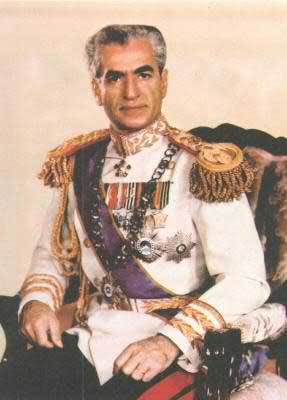
| His same moralizing about not working with the Shah, unless he became less oppressive in his handling of his opponents, served
greatly to undercut the position of the Shah in Iran. Carter soon
realized the dangers of what he had been pushing in Iran ... and
changed course. But it was too late to save the Shah from the damage done with all of Carter's earlier moralistic posturing.
By 1978 Iranian
students were freely protesting the Shah’s
government.
|
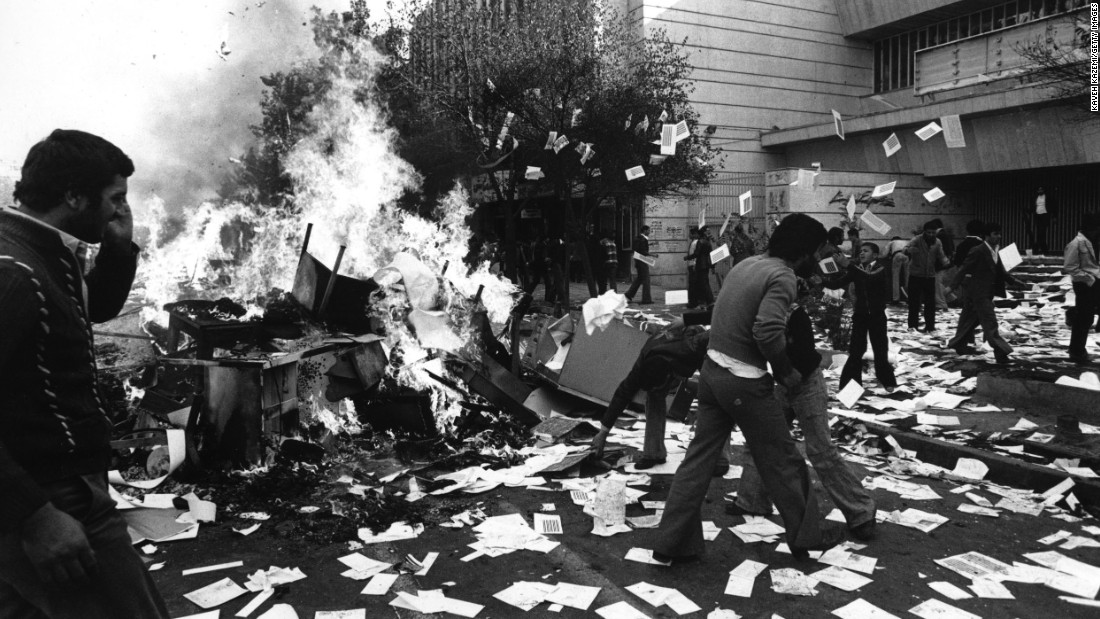
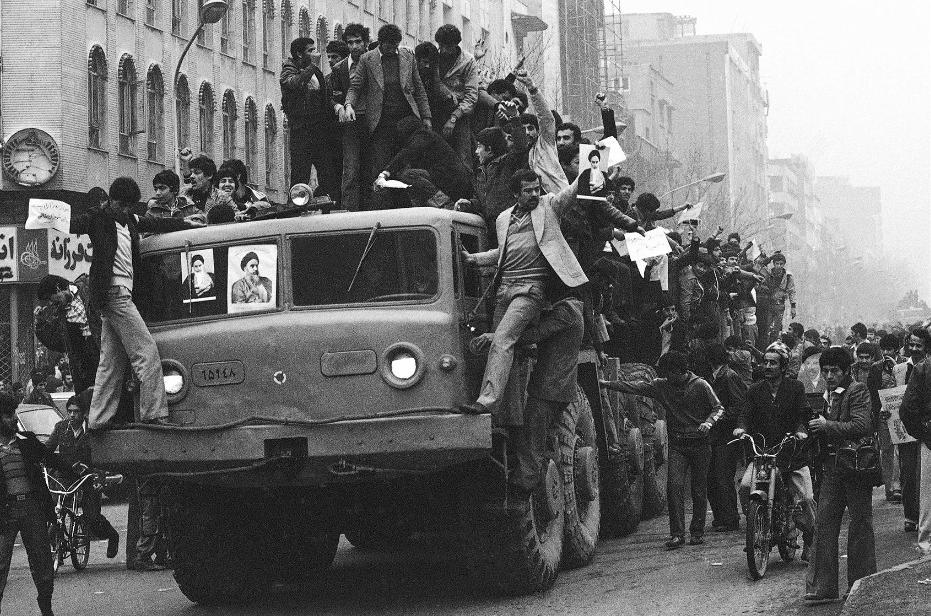
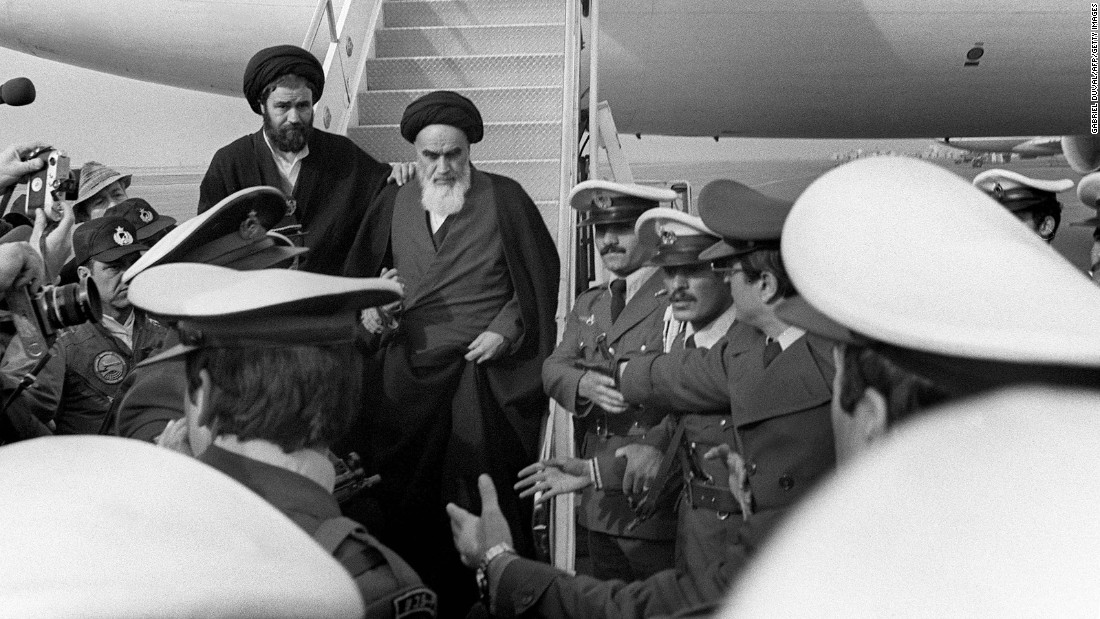
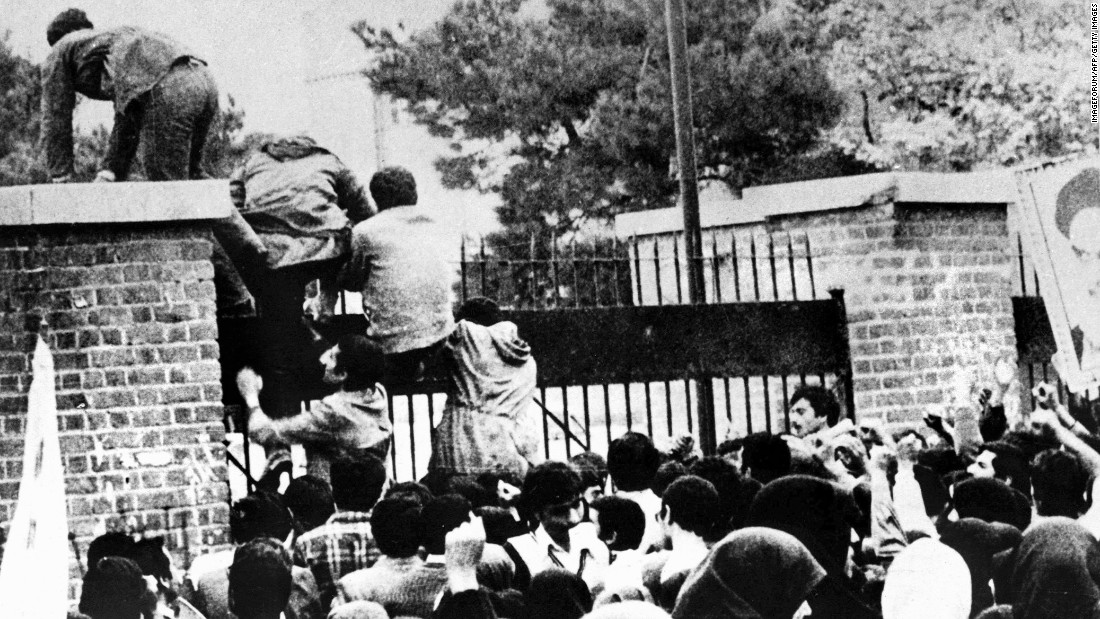
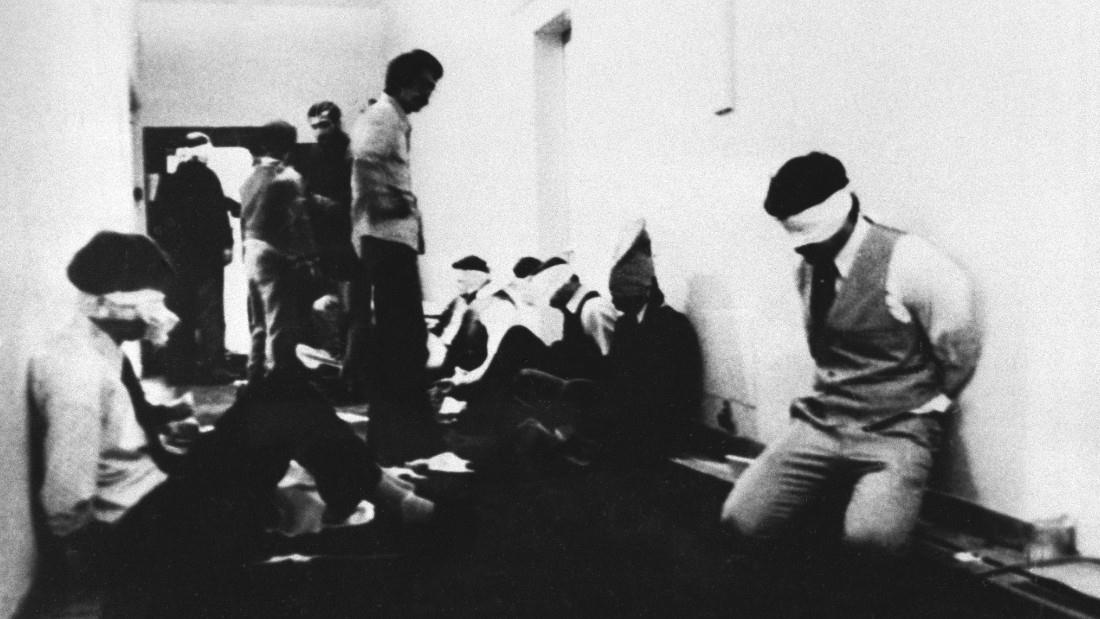
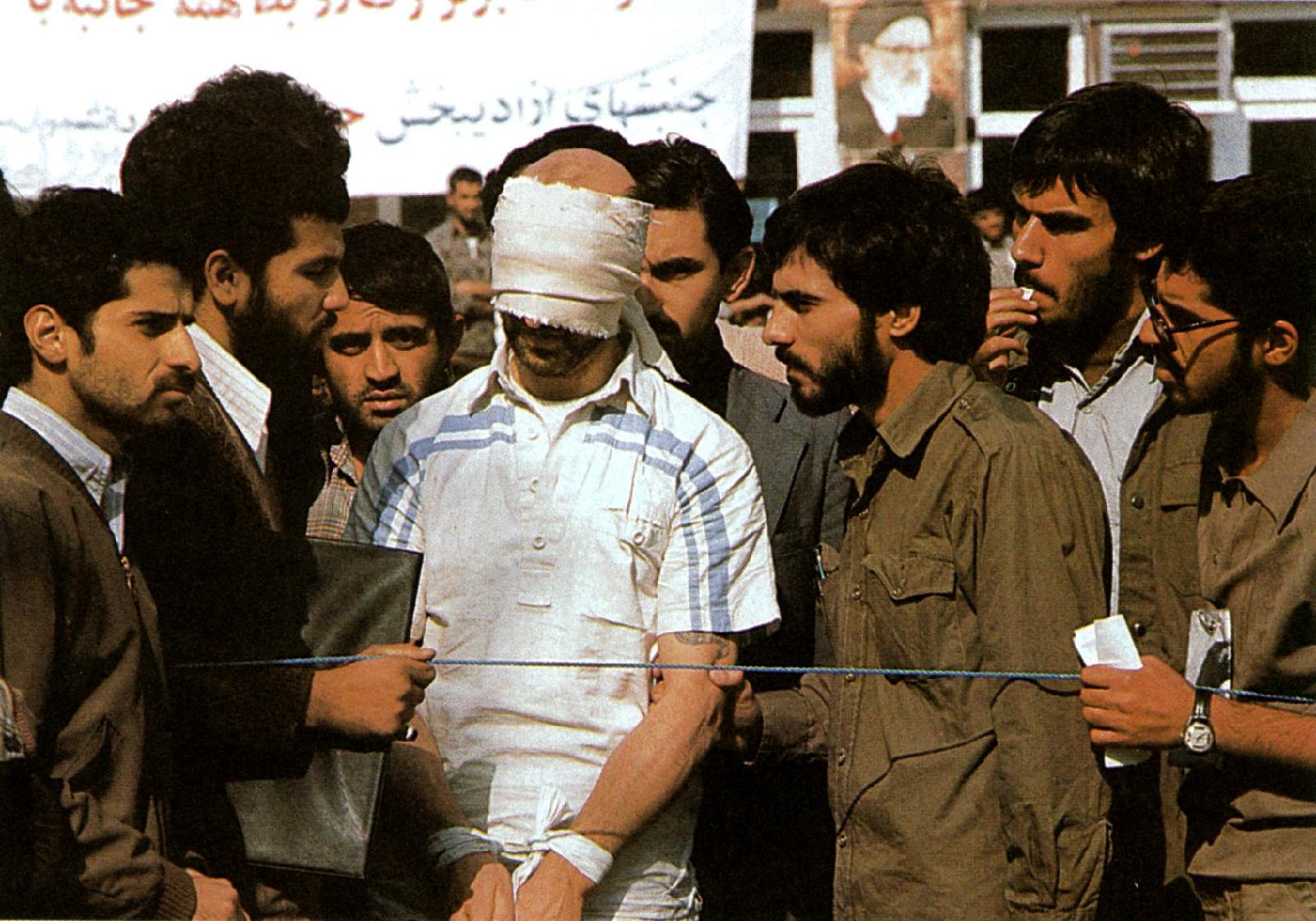

|
|
Housing restoration as a sideline
In the meantime, a new project in Mobile offered me some possibilities for a new challenge. As already mentioned, Tony advanced the idea of forming a partnership between the two of us and going into a sideline business of buying, restoring and selling homes in some of the other historic districts in town that were starting to show some early signs of revival. He was a banker by profession and I was a carpenter-architect by instinct – a good combination for such an enterprise. Thus the Mobile Restoration Company was born. We started out with just the four of us (husbands and wives) doing the work – but soon found that we had to subcontract more and more of the work, especially as we started taking on additional homes. Our work was high quality work, the kind we were proud of. Our very first efforts brought historic preservation awards! The work was also moderately profitable – and so our involvement grew. Eventually we also moved into suburban development with others, until by the end of the 1970s, we were heavily into the housing construction scene on all kinds of fronts. Taking on the redevelopment of the house next door (1978-1979)
The house next door to ours (a local park was on our other side) was owned by a classic slumlord who rented out rooms at the house by the week(!) and who did little upkeep on the house, but who did put out rat poison to deal with that problem, also poisoning one of our two cats who sadly ate one of the dead rats. The tenants were a rowdy lot. Some, we knew, even were prostitutes, doing business right there next door! And it had come to the point that this was the only house in the neighborhood that had not been bought by a young family and upgraded in the Oakleigh "gentrification" process. Thus what a surprise it was when we returned from our 1978 summer jaunt in Europe to learn that this house next door had been purchased, not by a young family but by a young slumlord who had plans to turn it into a number of cheap apartments. In our discussions with the new owner, we learned that he planned to put $10,000 to $15,000 in it to "fix it up," enough to create some separate apartments in the house. Actually, the house needed about $50,000 or more for a decent renovation. Nonetheless, the investment plans of the new slumlord would involve just enough money to put its cost beyond the reach of someone someday wanting to buy it to turn it into a family home. Thus it looked as if the house was to remain a slum forever. This was a shocking development for us – who were sort of cornered between this house and the park. This definitely would not help our property value any. So we got together with Tony and Tish and worked out a deal with the new owner to buy it off his hands for his purchase price and $5,000 extra. This was way more than the house was worth. But there seemed to be no alternative. By agreement with Tony, the responsibility for the house ultimately fell to me, because it was a bigger problem for me than for him. Fair enough. Nonetheless, we started the restoration of the house with high hopes that this would work out nicely for all of us in the end. Indeed, the four of us, Tony, Tish, Martha and me, put our hearts into the task, and did substantial redesign to the house, both outside and in. And by the next spring we had a house of some beauty next to us. |
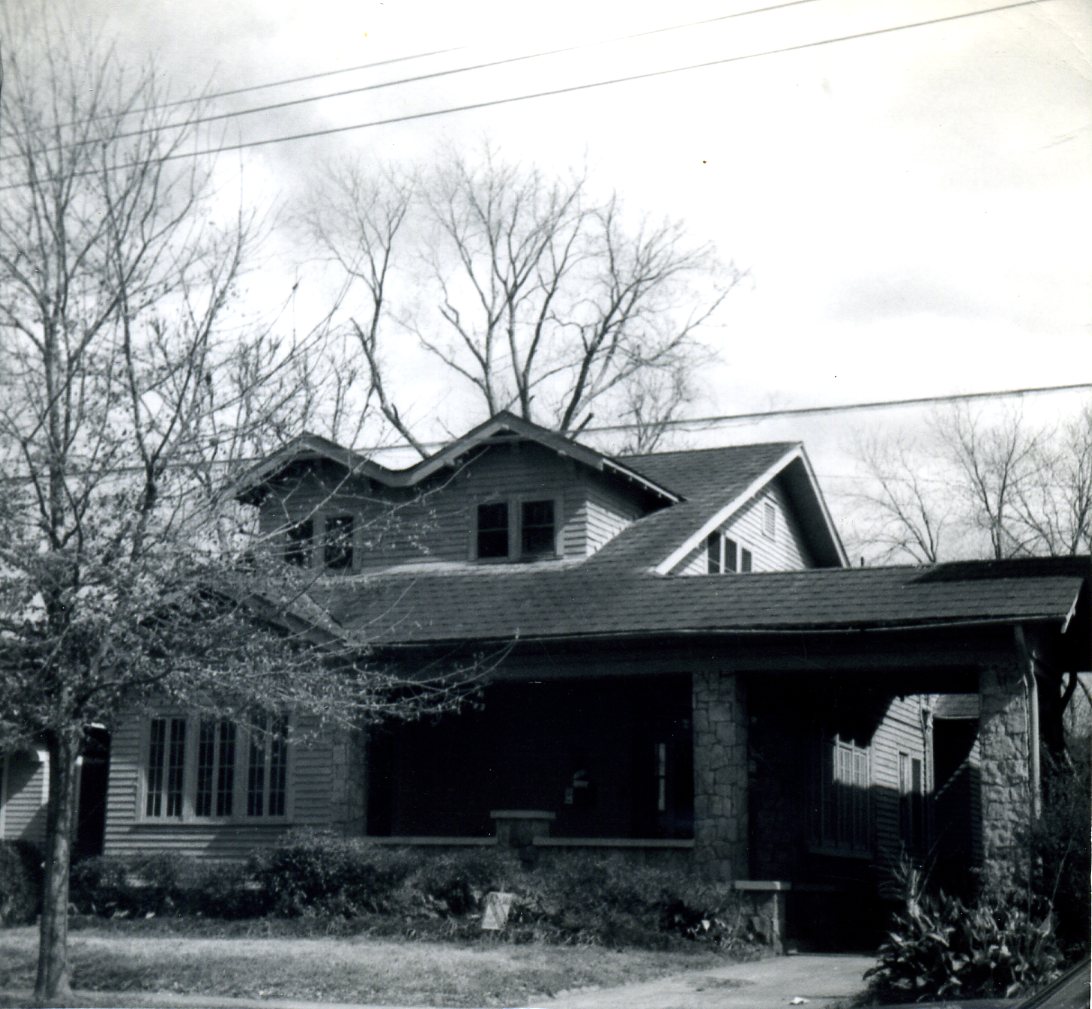
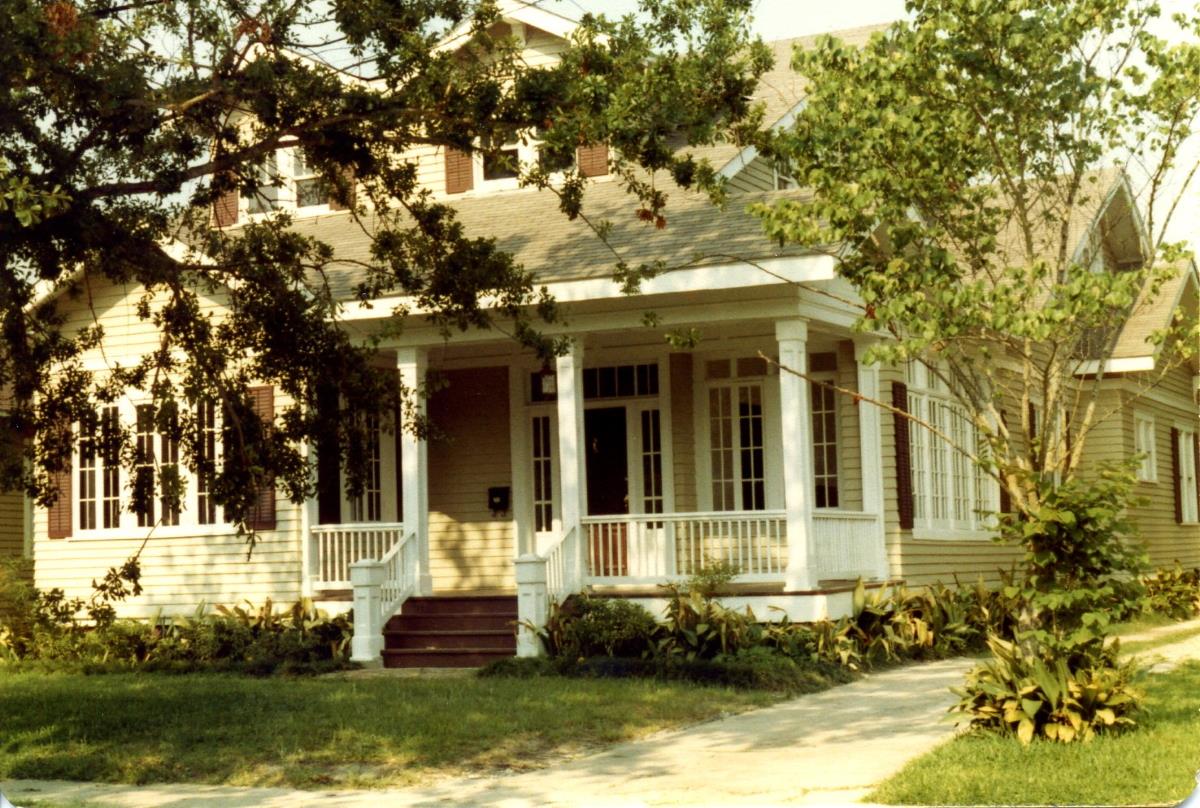
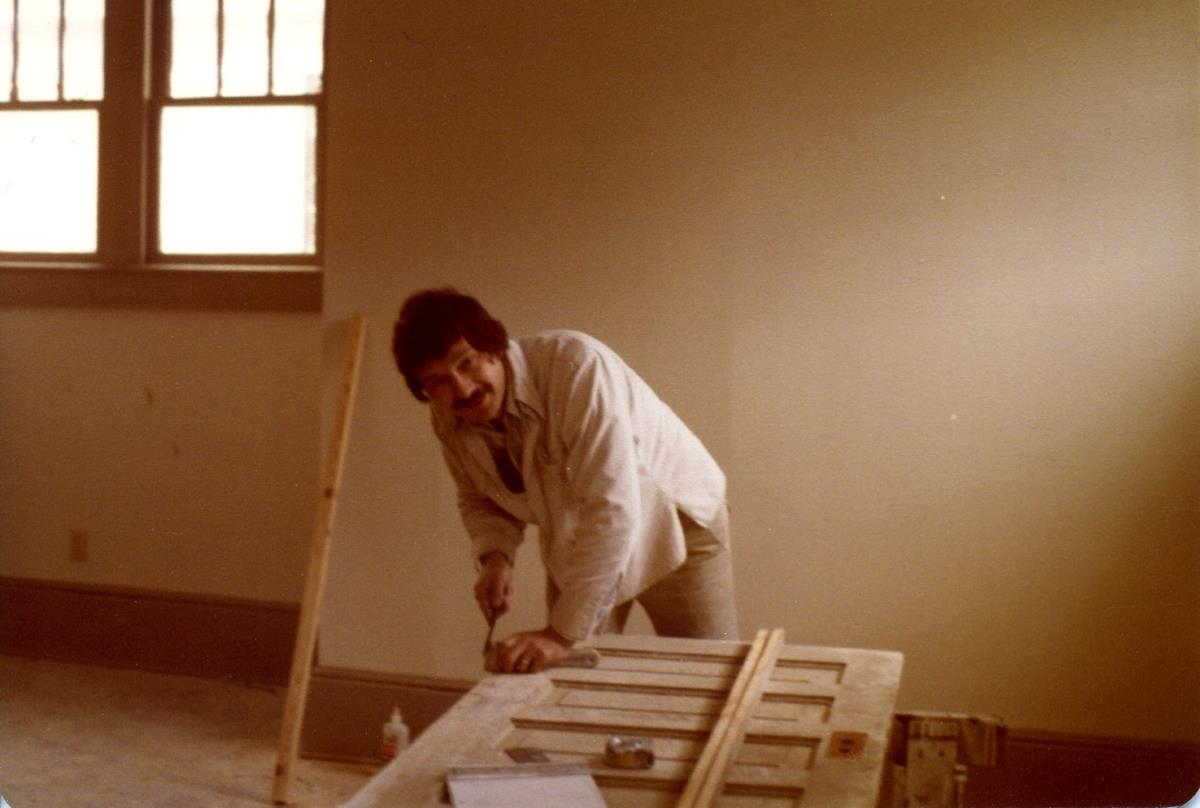
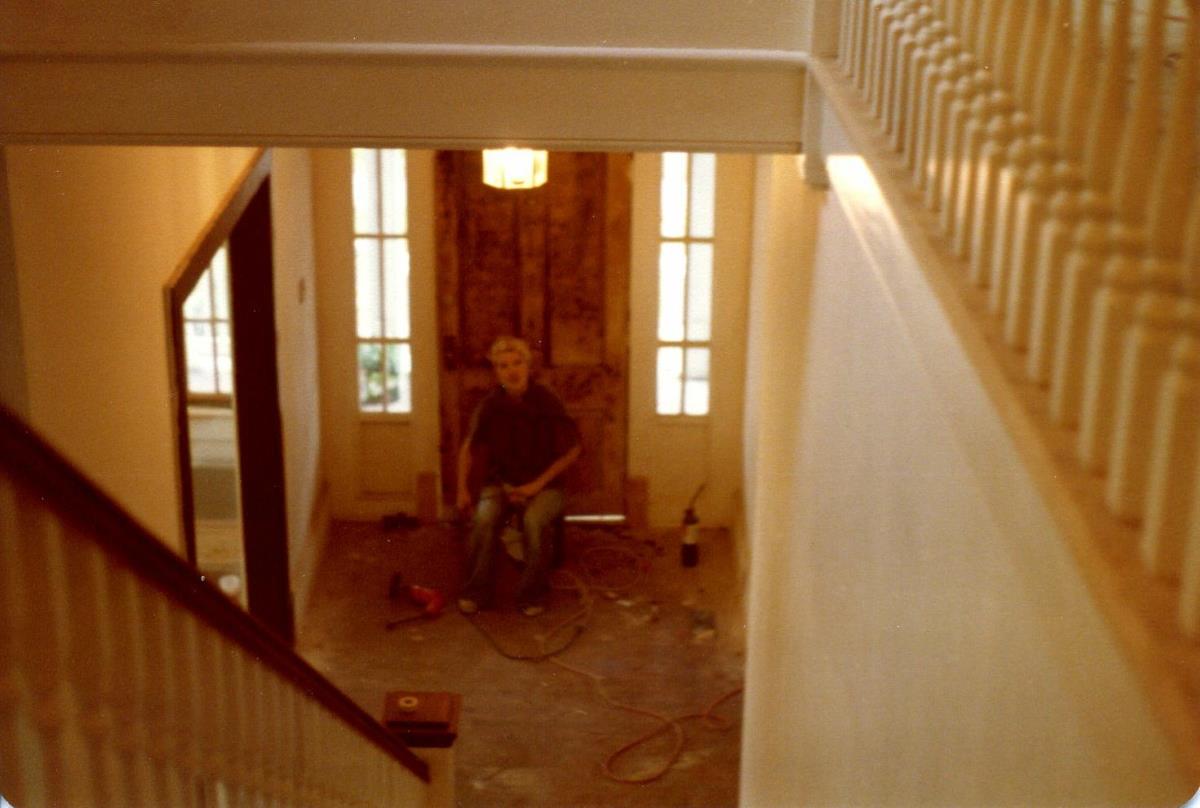
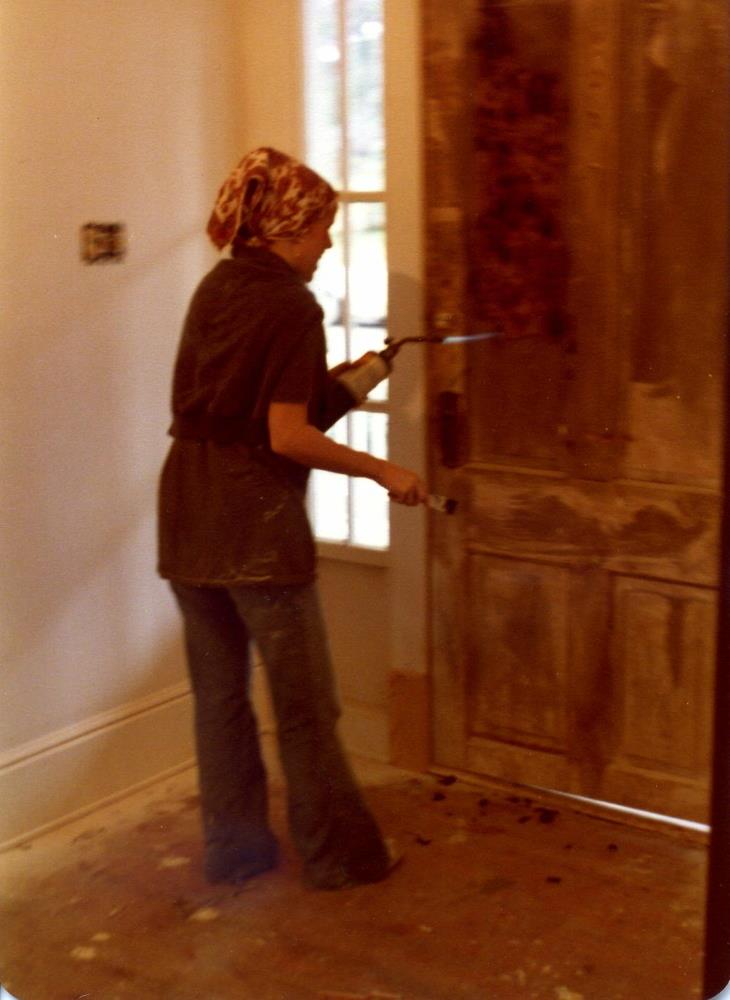
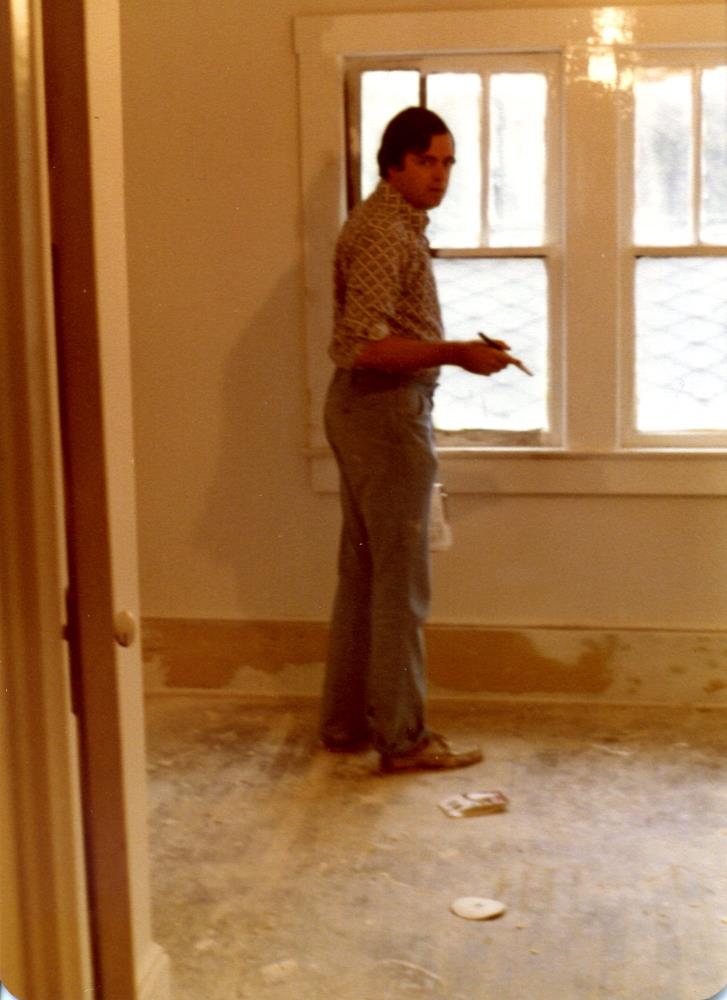
|
Our first problems in the housing renewal business
At the same time that we were busying ourselves with the work on the house next door, we were discovering big problems developing with one of our projects downtown. We had finished the restoration of a two-story beauty in the Church Street East District and had it up for sale. But unlike our first two houses, we could not find a buyer for the house, because the city, which had asked us to join them in restoring this particular district, was not moving to restore its houses. Their houses just sat there as festering sores, inviting problems for themselves, and for us. Until the city started moving on its part of the restoration effort, our house was destined to sit there vacant. Who would want to buy a beautiful house in the middle of an urban slum? But not only was it vacant, it was being pillaged. We were pretty certain that the family living in a rundown house across the street from our project house was helping itself to the kitchen cabinets, stoves, dishwashers, water heaters, even major heating/air conditioning units from the house. Indeed, we replaced some of these twice as we looked for a purchaser. We finally decided to rent the house as an effort to halt the pillage. But even here, we had to make some serious compromises. We found two divorced women with a large number of children who were willing to rent – at a rate that hardly covered the interest costs of the money we had borrowed to fix the place up – never mind the high attrition that renting would bring to the overall value of the house. We knew we would have to repaint and do extensive repairs again when they moved out in order to sell the house. Somehow the restoration business was fast losing its luster. Worse, the women moved out after a relatively brief period there – because the area was so troublesome for them and their families. And when they did, they left behind a needed paint job, some serious repairs required for the floors and some re-wallpapering. But thankfully, the people across the street had also moved out, and it looked as if there might be some renewed action in the neighborhood by the city authorities. So we left the house vacant – where it remained as such for the next year or so. What a disaster, as we paid out each month for interest costs – without any prospect of a sale until the city got moving on its part of the agreement! |
| Then the Mobile Housing Authority asked us to put our talents to work in joining the city in restoration-work in the Church-Street-East district. We agreed. Tragically, trying to work with the city would turn out to be a huge mistake. |
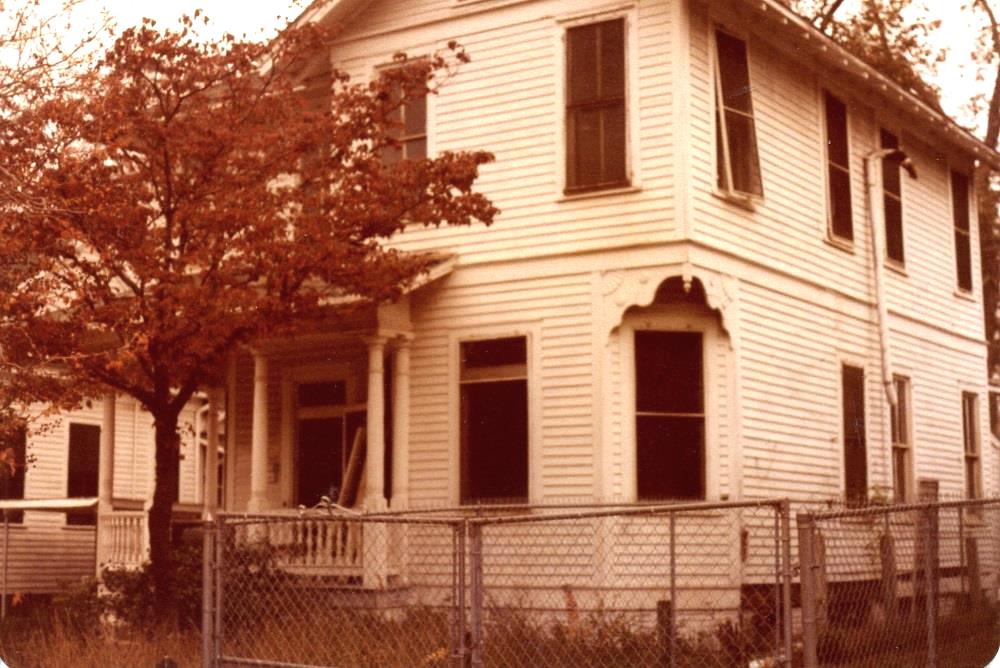
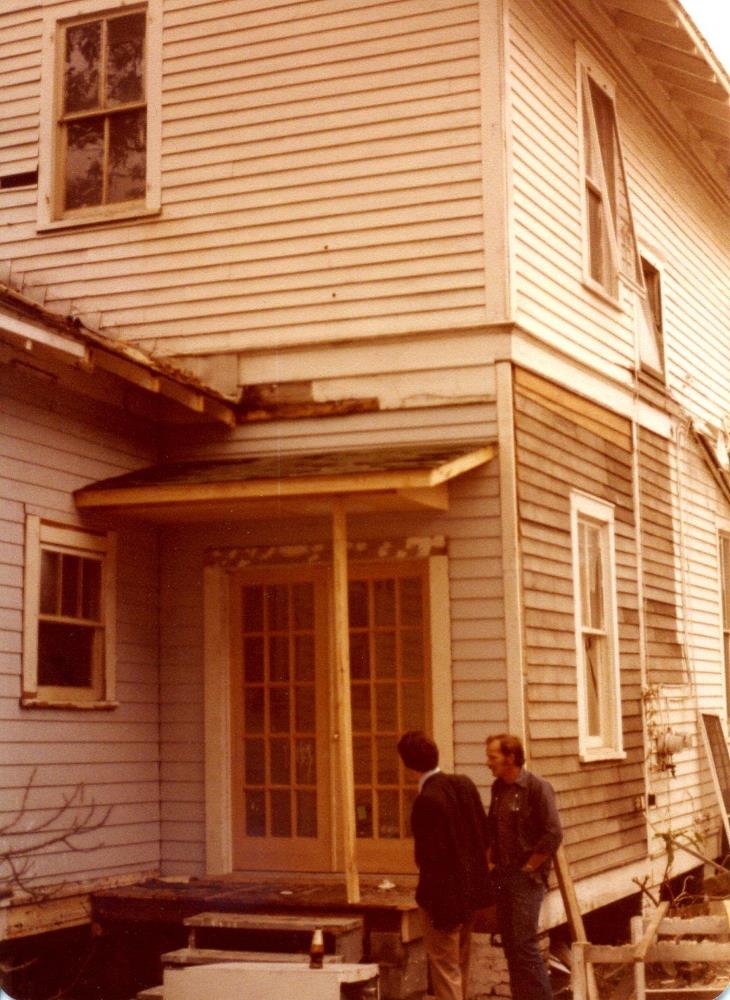
| Me consulting with a sub-contractor on our Church-Street-East project undertaken as part of our effort to work with the city in its own restoration work. A very bad idea! |
|
Problems finding a sale on the house next door
Meanwhile, the house next door was finished and ready for sale. But we came up with only one serious offer, for $10,000 less than the money we ourselves had invested in its purchase and development (not to mention all our personal labor)! As the months went by, we grew anxious – for we were shelling out $780 a month in interest costs for yet another empty house. By the time summer rolled around, Tony announced that he was backing out of the deal. As we had previously agreed, Martha and I would be the ones ultimately left to contend with any financial problems brought on by the project next door. Finally, just before the summer began (and we needed to leave for a new summer project), we found a renter who was willing to pay $550 a month. This helped enormously – leaving us with only a $230 monthly shortfall. In the meantime, we hoped that the house would sell. |
| I spent the summer of 1979 studying the history of urban planning at SUNY (Stony Brook) on Long Island … which back in Mobile I turned into a grad-student course on the politics of urban planning. |
|
Urban planning as a new line of study (1979)
Nonetheless and still overall, my work in housing restoration, plus my earlier involvement in Mobile's own well-organized effort to reconstruct its economy after the closing of the Brookley Naval Air Station, were activities that arose naturally out of an instinct of mine to want to see local communities take a stronger hand in their own development (I was not a big "let Washington do it" kind of guy!). And thus I applied for and received a grant to study the history of urbanization (with a personal research project on town planning) during a summer session (1979) at the State University of New York (SUNY) campus at Stony Brook on Long Island. There we rented a very nice little cottage from a professor who was away for the summer. And we enjoyed the experience very much – for Stony Brook was a small "New England" fishing village on the northern shore of Long Island. Martha was able to take sailing lessons while I studied. We also cooked gourmet-style, experimented with various fine California wines, and did some entertaining of other people on the same study program. |
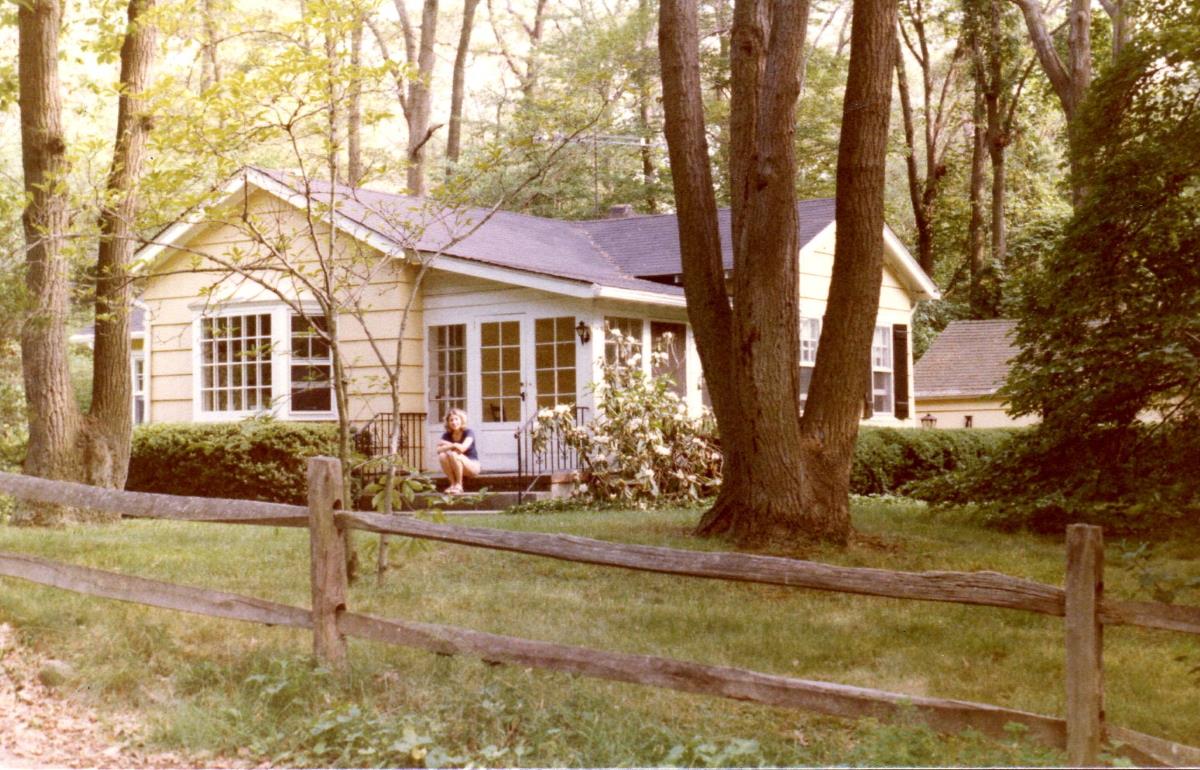
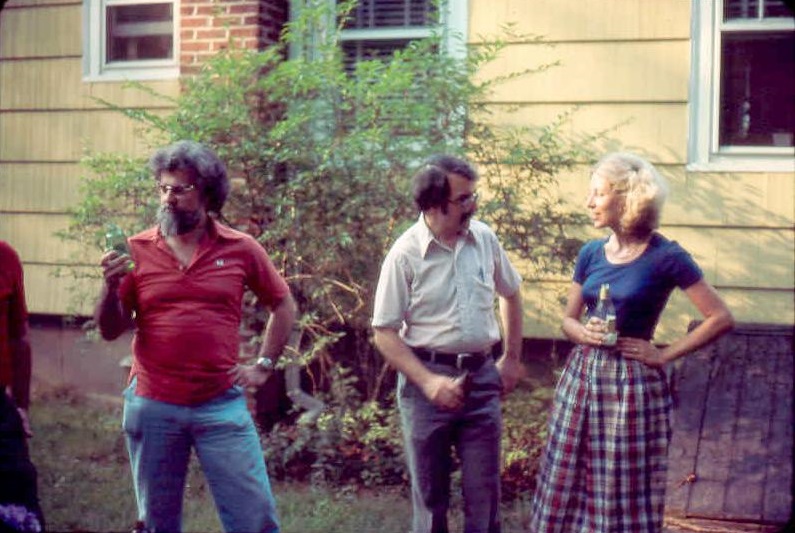
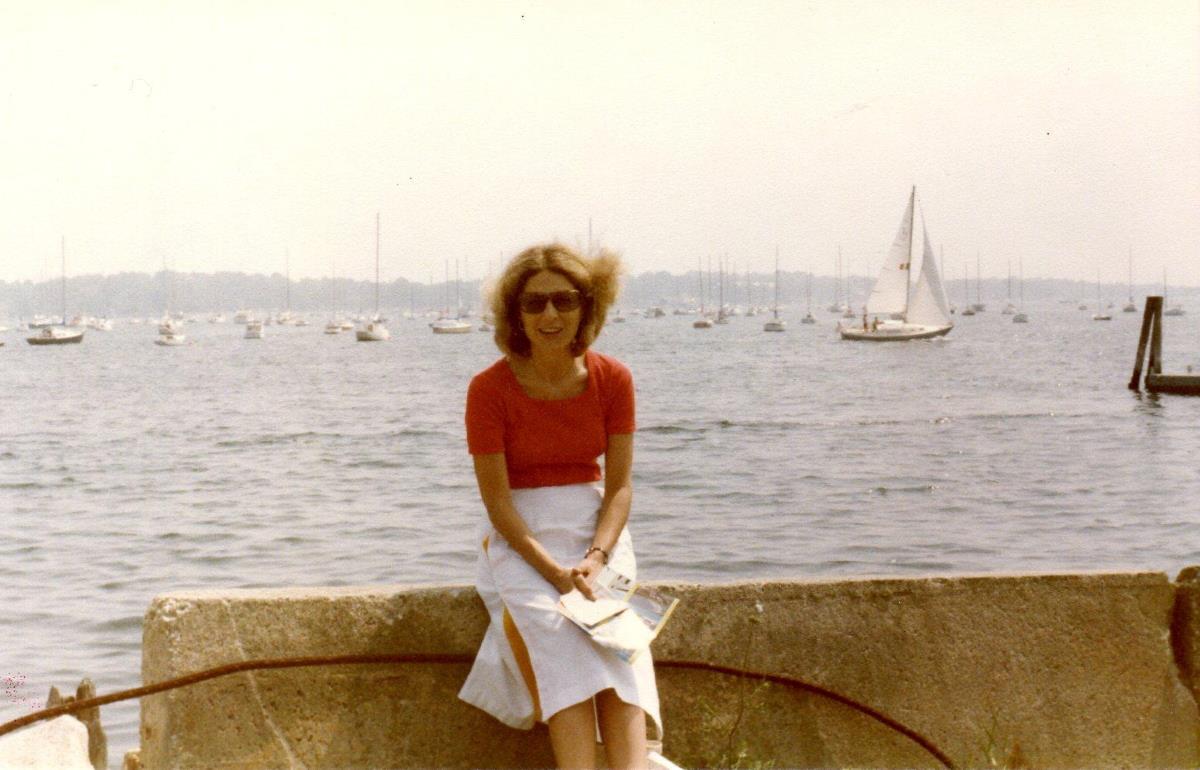
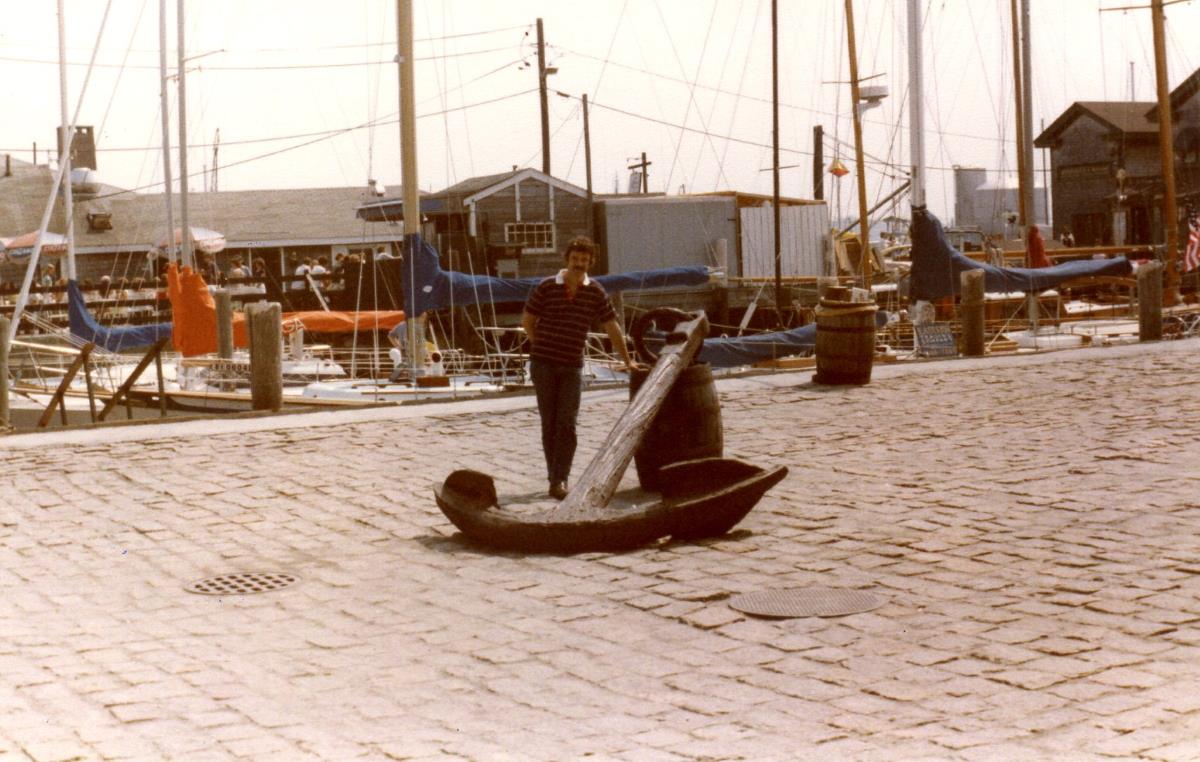
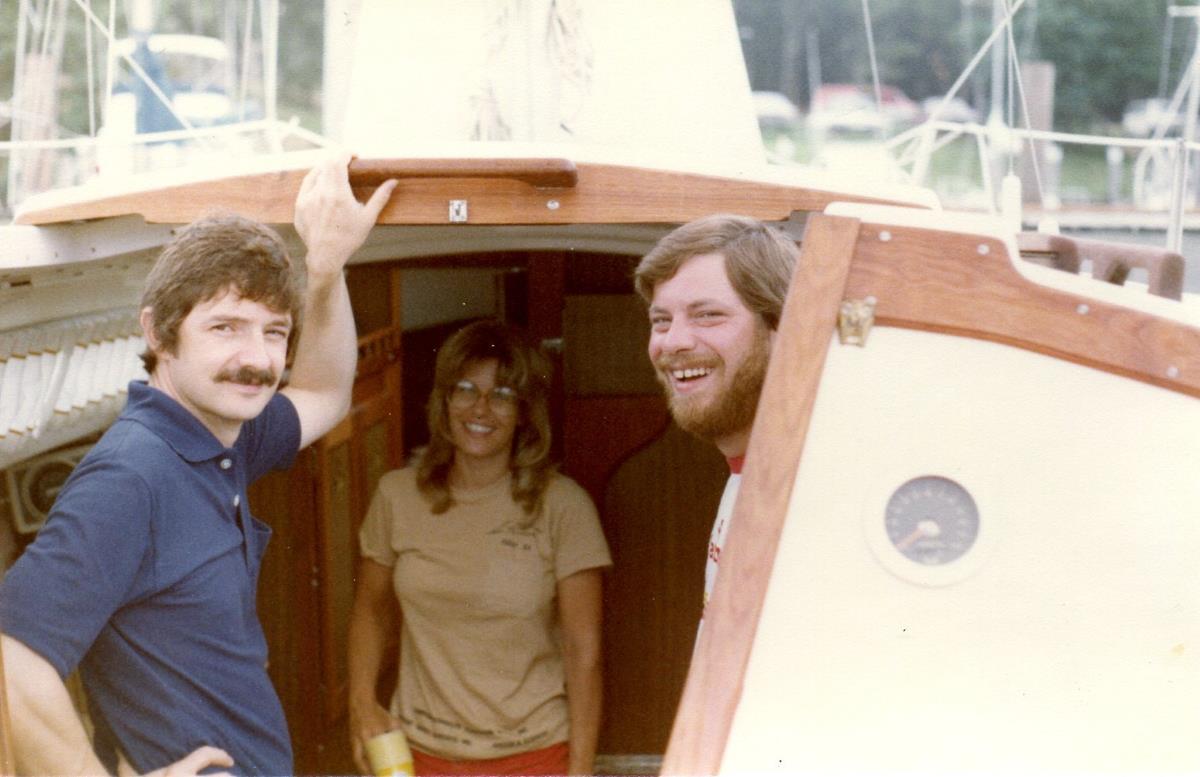
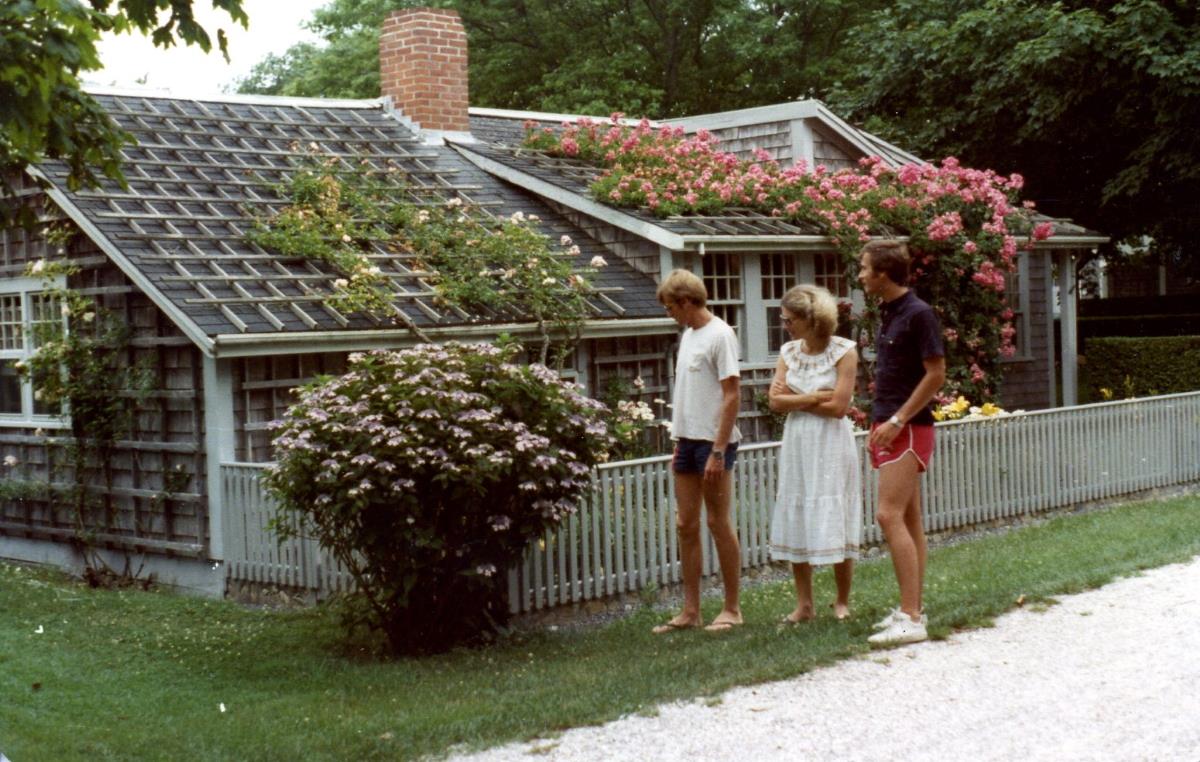

|
| That same summer a massive oil shortage developed as Iranian production dropped away due to all the chaos. For the second time in the decade, gasoline became scarce for Americans … lines at the pump grew very long … and the price of oil doubled – then doubled again. |
|
The 1979 energy crisis
One of the strange (actually ominous) features of the summer was the gasoline shortage, ostensibly created by the collapse of the Shah's government in Iran and the skyrocketing oil costs which resulted as OPEC manipulated shortages in the oil market (and American refiners manipulated the retailing in the United States). We had to watch our traveling – for gasoline was not always to be had. Also, and what we did not know at the time, this oil shortage – and the inflation that it produced – would come to have a much bigger impact on us than simply the shortage (and thus dramatic price increase) of gasoline for our car. It would have a major, even devastating impact on our lives, because of a very bad financial strategy that was about to be put in place in Washington in response to this situation. Anyway, in returning to Mobile that fall, I threw myself into a new graduate-level course I had developed: the politics of urban planning (presented historically). I enjoyed the course very much, as did the students. And I was hoping greatly that somehow this would open up some new specialized field for me to devote myself to. But in the end, I never really figured out a way to make it work for me. That was too bad.
Late 1979: financial bondage sets in deeply
In the meantime, the too-bad was becoming horribly-bad! Because of the new energy shortages, energy prices had unsurprisingly risen greatly over the summer, in fact quadrupling for the second time that decade. But the price inflation did not stop there. These massively higher energy costs were now also forcing prices of finished products and other consumer goods to also have to be raised, in order for producers to be able, after paying for the new energy expenses, to still be able to pay their workers (who also, in the face of this inflation, were wanting accompanying salary and wage increases) and find a bit of profit for their investors. Thus massive inflation hit the country in all areas of the economy, as prices for most everything (food, clothing, furnishings) joined energy prices in a dramatic increase across the board. Then just to make the suffering for everyone worse, at the end of 1979 the interest rates on bank loans (including our own) suddenly skyrocketed as well. 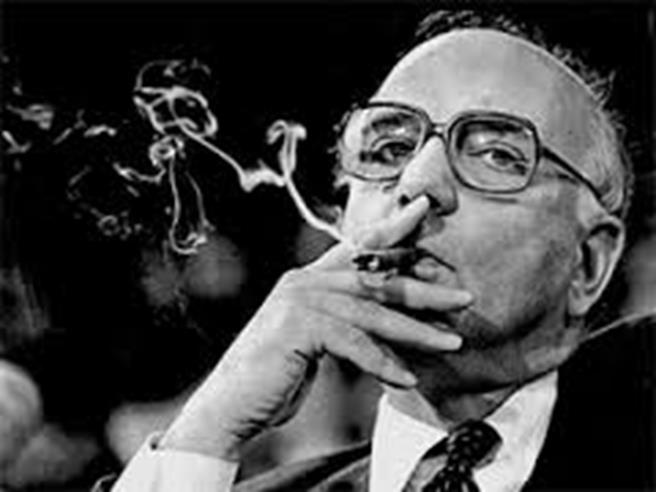 This is because Paul Volcker, the President of the Federal Reserve Board, had stepped into things by claiming that he was intending to destroy the power of inflation single-handedly, with an excruciatingly tight monetarist strategy. In other words, he was going to increase the Federal discount (interest) rate charged to banks that borrowed from the government, even increase that rate massively if necessary! And of course, by increasing interest costs to American banks, those higher interest rates would be passed on to the bank's own customers, Tony and me included. I had no idea of what the logic behind this move of Volcker's happened to be. Volcker's vastly higher interest rate strategy would make a producer's operating costs – costs already driven sky high because of dramatically increased energy and commodity prices – even worse. Borrowed money was an operating cost for a business just like energy and basic materials. Upping interest rates would force a business to have to raise even further the pricing of its own goods, if it intended to make any kind of a profit at all. In short, higher interest rates were guaranteed to increase inflation, not bring it down! What was the man thinking? Was his idea of "fighting inflation" one of destroying the entire US economy? People (like ourselves) whose businesses depended on bank loans suddenly found themselves trapped with business inventories (cars, homes, goods) that would not move. Customers for these goods disappeared overnight. No one was willing to buy a new car or a home when interest rates were now running at 16 to 18% or more (Volcker even pushed things up to where the prime rate was at 22% at one point). There was nothing a person could do that got caught holding business inventory when these rates suddenly jumped skyward, except pay the increasingly higher interest rates that banks were charging – while waiting desperately for the merchandise to move, for something to happen that would get them out of this trap. And that is exactly where Martha and I now found ourselves at this point. Here we were holding all of this property, property that we could neither sell – nor could afford to continue to finance. The earnings we had made from our restoration work thus far were quickly eaten up by the high annual interest rates (20%+) that we were forced to pay quarterly on the property we were still holding. Soon our salaries were going to make interest payments, payments that were almost as much as our combined salaries. What were we going to do? Very quickly our savings were depleted. Then we refinanced the house (at a much higher interest rate) in order to secure cash to pay the quarterly interest obligations. How sad this was: the house was almost completely paid off. Suddenly we went from making $188-a-month payments on a $4000 balance left on the house to nearly $400 a month for a $30,000 balance. The cash we secured through this refinancing bought us some time with the other interest payments of course. But we knew this would rescue us only for a while. We kept hoping that the Federal Reserve would bring interest rates back down. But it didn't. Slowly we were being bled to death financially.
Bewilderment
This all came at a very bad time for me – for I was already beginning to get very restless about my life. I was feeling "trapped" – the one thing I feared most from life. I was "trapped" in my teaching job – in the sense that I could not think of any new things to take on professionally that would stir my blood the way I was used to having it stirred. The urban planning idea had seemingly led nowhere. And as I surveyed the professional alternatives – they all seemed to promise merely more of the same thing. It was simply more of being "bored in Paris." Then just to make things worse, toward the end of the spring next year (1980) our tenants next door announced that they had bought a house up the street and would be moving out. But then our realtor friend Nancy (whom we worked with in a number of earlier sales) brought by a man who was interested in a lease/purchase arrangement. I was a bit leery of the idea – but also desperate to get some kind of action on the house. So we closed the deal. The family moved in. But somehow all his talk about family money, etc. by which he hoped to buy the house sounded suspiciously unreal. It was. |
| The summer of 1980 Martha and I moved into a house in Georgetown for me to study Arabic at the Johns Hopkins SAIS campus in Washington. Actually I spent a good deal of that summer interviewing for a position at the CIA … not as a researcher but as an operative! (was I going crazy?) |
|
The summer of 1980, back in DC
Anyway, at that point we were off to DC for a 10-week Arabic language program at John Hopkins' Washington campus just off Dupont Circle. But those Arabic classes nearly killed me. I got only about 4 to 5 hours of sleep a night. I found myself cramming, cramming, cramming. On the weekends we headed over to nearby Annapolis – sometimes with my former student and friend, Jim, who was working in DC at the time. Towards the end of the summer, we even went over in the evenings, just to get away from the pressure. In fact, it was really therapeutic to walk along the waterfront and look at the boats, to buy soft-shell crab sandwiches from the fish market at the wharf, or to drink cocktails on a veranda of a restaurant overlooking the water. One time I spotted a beautiful sailboat sailing out in the Chesapeake Bay: dark blue hull and light blue genoa sail. Oh how I would love to have such a boat! Thus the seed of what would turn out to be a very big deal was planted in my mind. That summer I turned 39. I got my first few gray hairs – probably from all the pressure I was under studying Arabic – and from all the money worries that awaited me back in Mobile. I was also probably losing my mind! I decided to interview with the CIA – as an "operative" (not just as a researcher). I spent a lot of time interviewing and preparing interview papers (when I should have been studying Arabic). I was such a bored, restless and "underutilized" individual. But did I really need to go this far? Anyway, thankfully that fall they broke off the interview process, for apparently the reason that I did not fit their psychological profile for an "operative." |
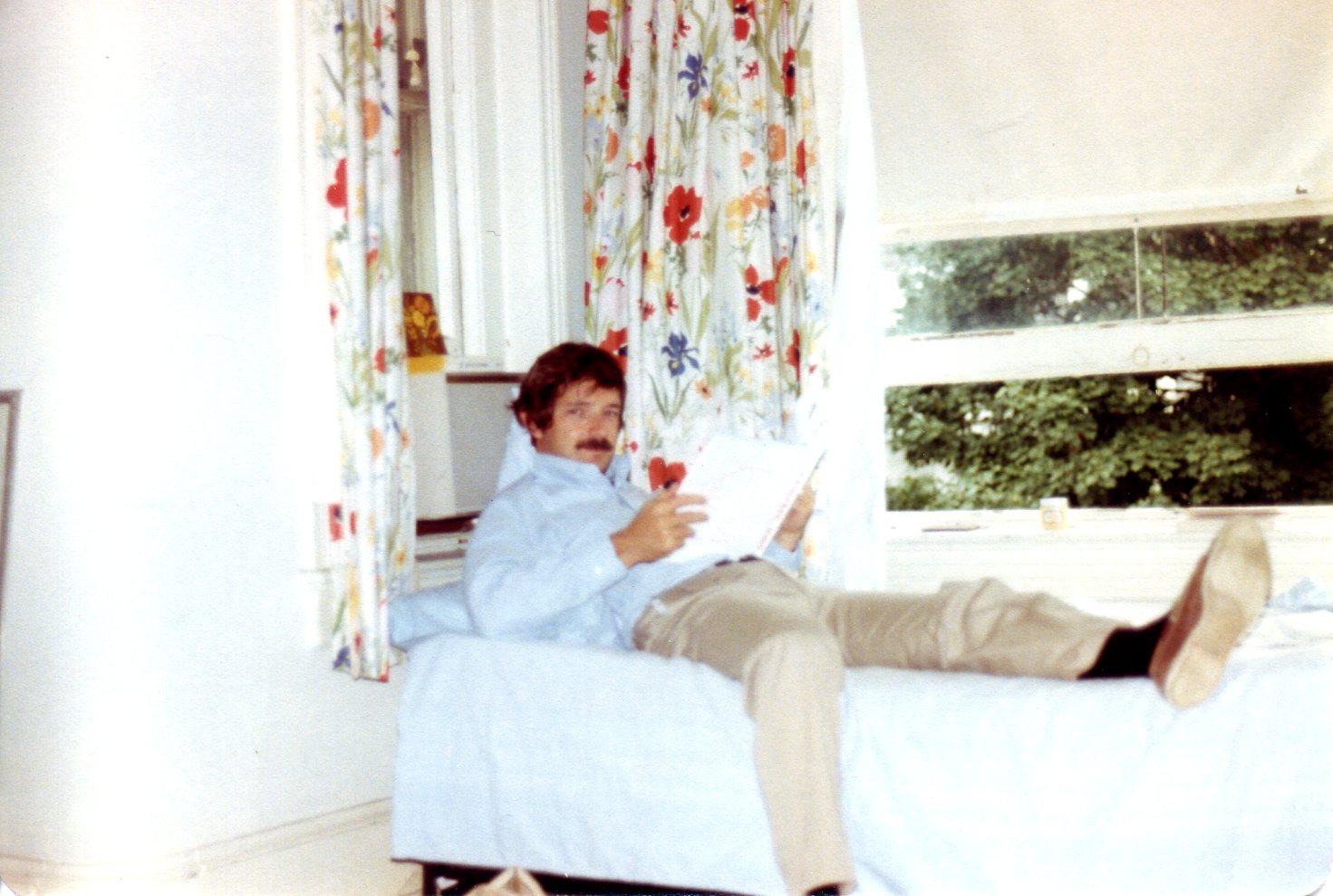
|
The Marionette
Trying to find some kind of activity to brighten our otherwise very depressing world, Martha and I bought ourselves a sailboat, to cruise (not race) and entertain on. It was that same summer that we spotted that beautiful blue-hulled sailboat ... one that we afterwards talked about quite a bit. And thus it was, towards the end of the summer we decided to go ahead and buy a sailboat of our own! Financially this was a very poor idea. But emotionally, it was the one thing that held off emotional disaster, at least for a couple of years. So we were able to locate a 30-foot sailboat (Catalina) for sale near Annapolis, about 4 years old and in fairly good shape. We arranged a second mortgage on our house and paid $27,000 cash for the boat. We had it shipped by truck to Mobile where it arrived about the same time we did on our trip back from DC. Then I spent my days before fall classes resumed working on the boat. I refitted it extensively inside and out and had the hull painted a dark navy blue (just like that one I saw in the Chesapeake Bay). I painted the lettering on the stern: Marionette. |

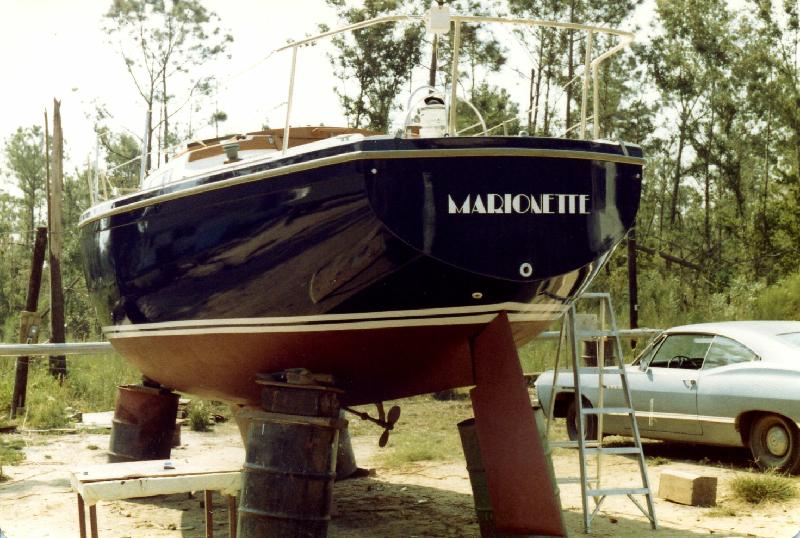
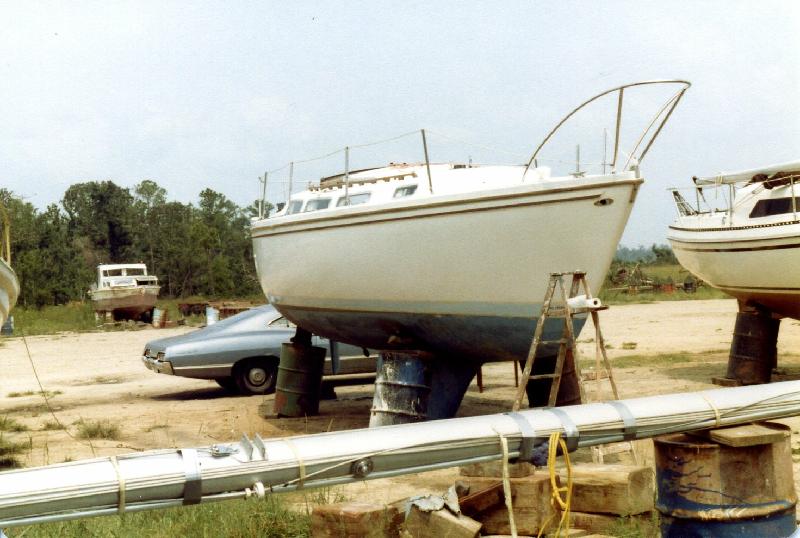

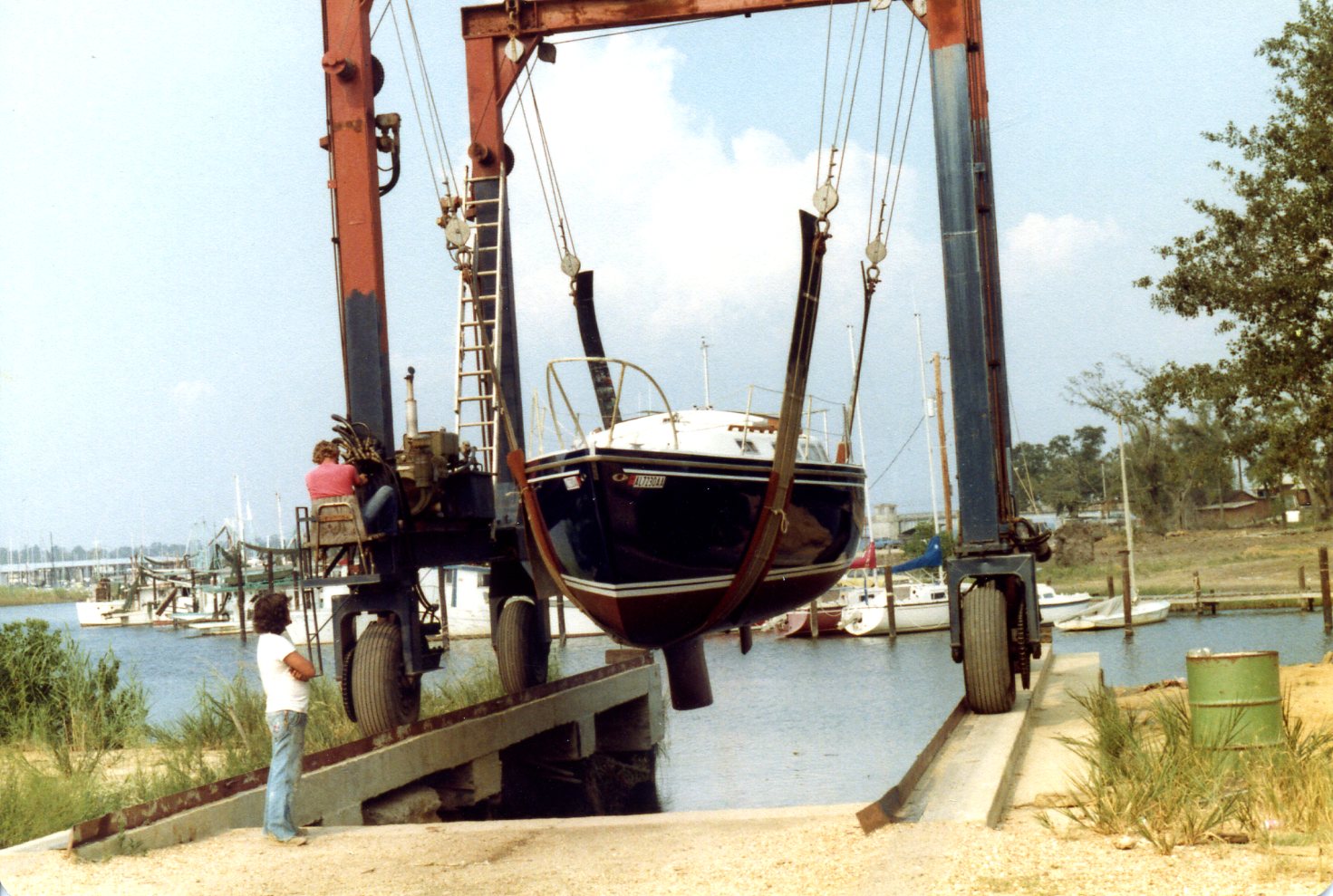
| And I did a considerable amount of upgrading: electronics (here I am installing radar or LORAN at the top of the mast), a self-furling genoa jib, a 9 cu. ft. ice box, a Bimini canopy, etc. |
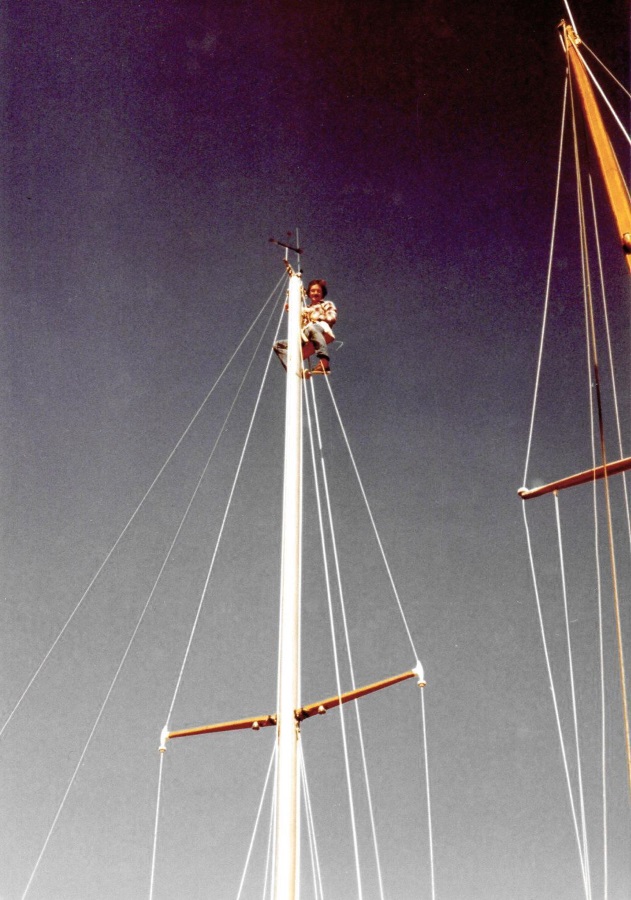
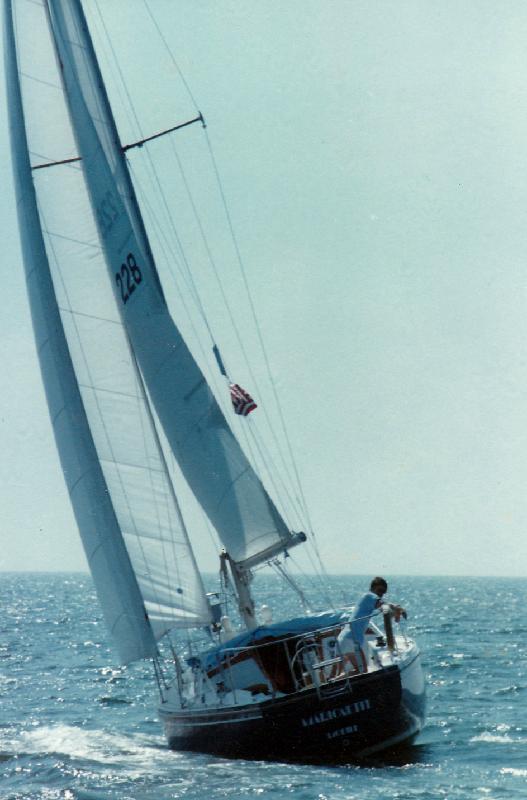
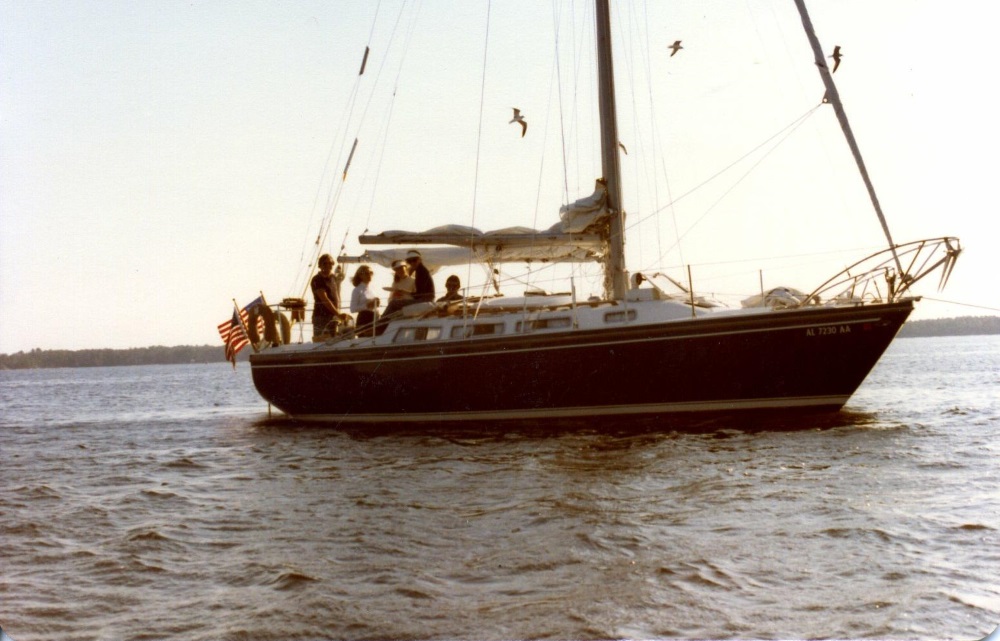
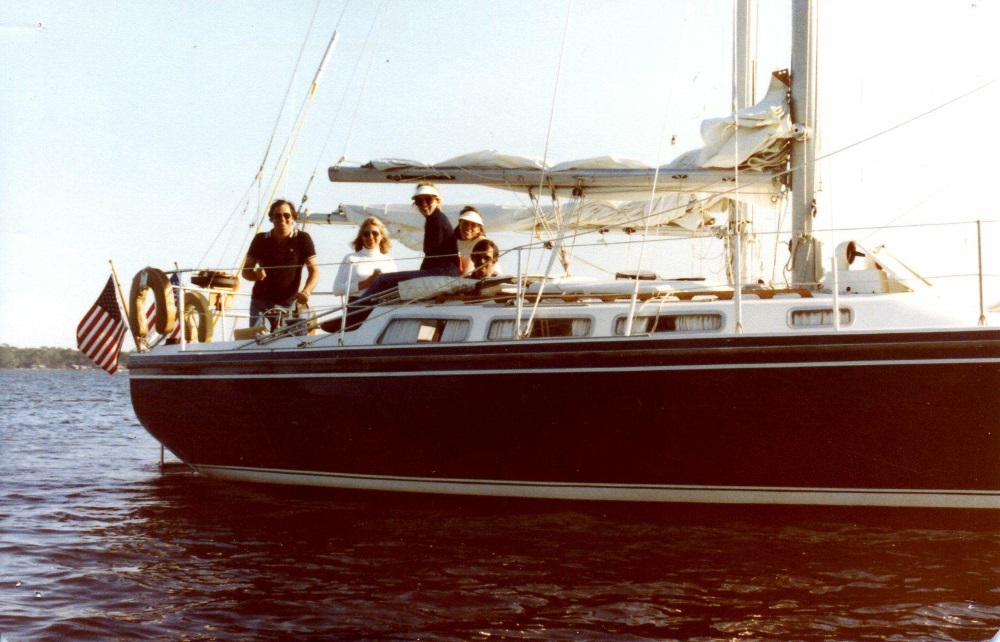
|
The house break-ins and robberies
But tragically also, the fall of 1980 also began the series of break-ins into our beloved house. Seven times (!!!) the house or garage (where all my tools were kept) were burglarized – despite all sorts of measures to alarm the house and garage against intruders. The first couple of times it felt as if we had been raped. Our house no longer represented the safe haven we had always thought of it being. It was no longer sacred or pure. In the subsequent robberies – in which little was taken because we simply did not bother to replace the stereo, TV, tools, etc. (the treasures from our various trips abroad that were stolen were of course irreplaceable) – we simply felt benumbed. Indeed, there seemed to be little point to the future robberies, except that the robber or robbers obviously felt "at home" breaking into our house. We lived next to a park – and thus were very vulnerable to any mildly enterprising thief, who could watch us come and go, and then make his move on our house, and then slip away through the park without raising any kind of alarm. The fact that a major drug distribution center was just on the other side of this park, and the fact that the park had been taken over by citizens from that particular part of town, obviously played a key part in our plight. None of them would be likely to report to police a robbery in progress. Just like the financial mess – we felt totally helpless, vulnerable in this matter. There was nothing we could do to remedy the situation. At one point, we tried to move to another house in the neighborhood. But after a very lengthy negotiating process, just as we thought we were closing the deal, someone (who had been tipped off in detail about our offer) at the last minute came through with an offer just a bit higher than ours. We were stunned. It was just as well, because we probably would have ended up with two houses – at a time when we certainly needed no more property. But it was another major blow for us. After that, we didn't have the heart to try another move away from our besieged home. |
| Then too there was the issue of the constant break-ins to our home around this time. The recently drug-infested park next door was certainly the launching point for those break-ins. |
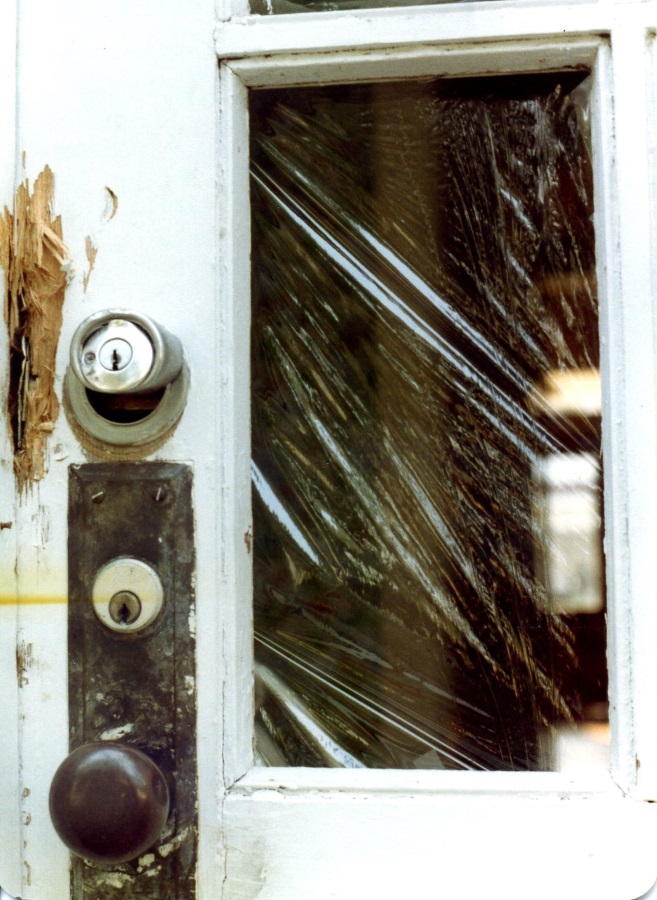
| The druggies cleaned us out … but still kept coming (seven break-ins). Our home was no longer a place of rest and safety. It was just like life in the slums of America’s inner-cities. We wanted to move … but knew that there was no point in putting the house on the market with the economic situation the way it was. |
|
My grandfather dies
Also, in the midst of the boat work and the break-ins, Grandpa died very suddenly of pneumonia, which he caught in the hospital where he was being treated for relatively minor injuries sustained during a mysterious auto accident he had in the parking basement under his apartment building. I flew out to Denver for the funeral. I didn't really have any great theories or feelings about death. I was sad, but not tragically so. The whole thing was, more than anything else, simply another addition to the increasingly numb feelings I was having about life. Political-risk consulting
Then for a while, in those same years, it looked as if I might be opening up a new avenue for myself professionally. Hope flickered to life as I began to cultivate business contacts, and found myself serving as a political-risk consultant to various banks – first in Mobile, then all the way over to Houston. I had quite good and well-proven predictive powers about what was likely to unfold in a given political-economic climate, and found that my work was well appreciated. I helped a number of banks make some informed lending/investing decisions overseas. For instance, I predicted the end to the oil price increase – even the resumption of new rounds of competition in oil pricing, thanks to a most-probable scramble to undersell its oil-exporting competitors that a money-short Russia was most likely to have to resort to, which I realized would then set off a new round of price reductions by oil producers trying to keep themselves in this very competitive market. My predictions proved (fairly soon) to be right on target, and thus helped a Texas bank that hired my services to avoid a major multi-million-dollar investment blunder in the Mexican oil industry. Eventually I was called upon to present seminars on the subject, first developed as courses with my own students at the university. And soon I found myself publishing articles on this subject as well. But the bloom on this rose began to fade almost as quickly as it flowered – because the early 1980s was also the time of the international debt crisis. As one banker put it to me: "we've stopped making loans overseas for the time being, because of the danger of default from our Third World customers. If, however, you could show us how to get out of the loans we're already in, we'd be very eager for your services." Of course this was a business operations matter – an entirely different affair from assessing political risk. So, once again I found this new professional path leading nowhere. My sense of frustration thus merely deepened. |
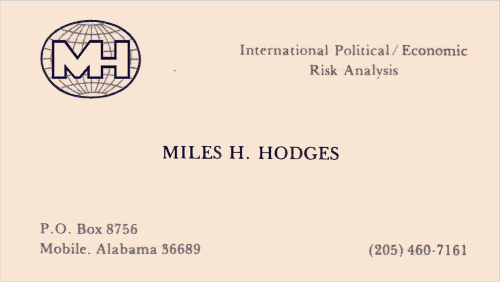
I had
made something of a name for myself by warning a bank about
the perils of lending to an
American company planning to do big business with
Pemex (the huge Mexican oil company) – because I sensed that Russia
was about to start pumping massive amounts of oil, which would drive
down the price (and profitability) of oil production and leave Pemex
unable to repay its debt to the American company and in turn the company to
the bank.
This
all actually then unfolded merely months later. The
bank was extremely grateful
for my advice.
Another time, a company used a report of mine to force the Bolivian government to stop delaying repayment on a loan – claiming that their "expert" (that was me!) had concluded that there was a grave danger that their national currency (the Boliviano) was about to devalue. Under this pressure, the government did pay off the debt – indeed, just before the currency underwent a huge devaluation. But my business began to dry up as Volcker’s economic policies began to have an ever- worsening impact on the world's as well as America's businesses. The banks now told me that they would be glad to hire my services if I could show them how to get out of their overseas involvements. But that was something that neither they nor I could possibly do. It was all very depressing. |
|
Depression and disaster (1981)
As I look back on it, I see indeed that the summer of 1981 was some kind of major turning point in my life. Martha and I had made plans to sail the Marionette with our Oakleigh friends, Cecil and Susan, cross the Gulf of Mexico diagonally to the Okeechobee Canal that cuts across south-central Florida from the Gulf to the Atlantic, and arrive at Fort Lauderdale. We would then sail onward from there to the Bahamas with Tony and Tish, and vacation there with them for a while before sailing home at the end of the summer. We expected and had planned for the usual mishaps along the way. But we hadn't planned on running aground at a very high tide at an unmarked bend in a South Florida waterway, costing us our rudder, an expensive dredging process to get us off our grounding, and a week in drydock for repairs. We soon ran out of most of our money. And when it was all over, there was nothing for us to do but sail back to Mobile and forget the rest of the summer. That fall I grew uneasy and restless, unable to sleep at nights. I worried about how we were going to make our next interest payments on our property holdings. I searched my heart for a sense of where my life could possibly be headed – which seemed largely nowhere, just like our trip to the Bahamas. It seemed that at every turn we had been thwarted by the same Fortuna that once had been our invaluable ally. I was despondent. |
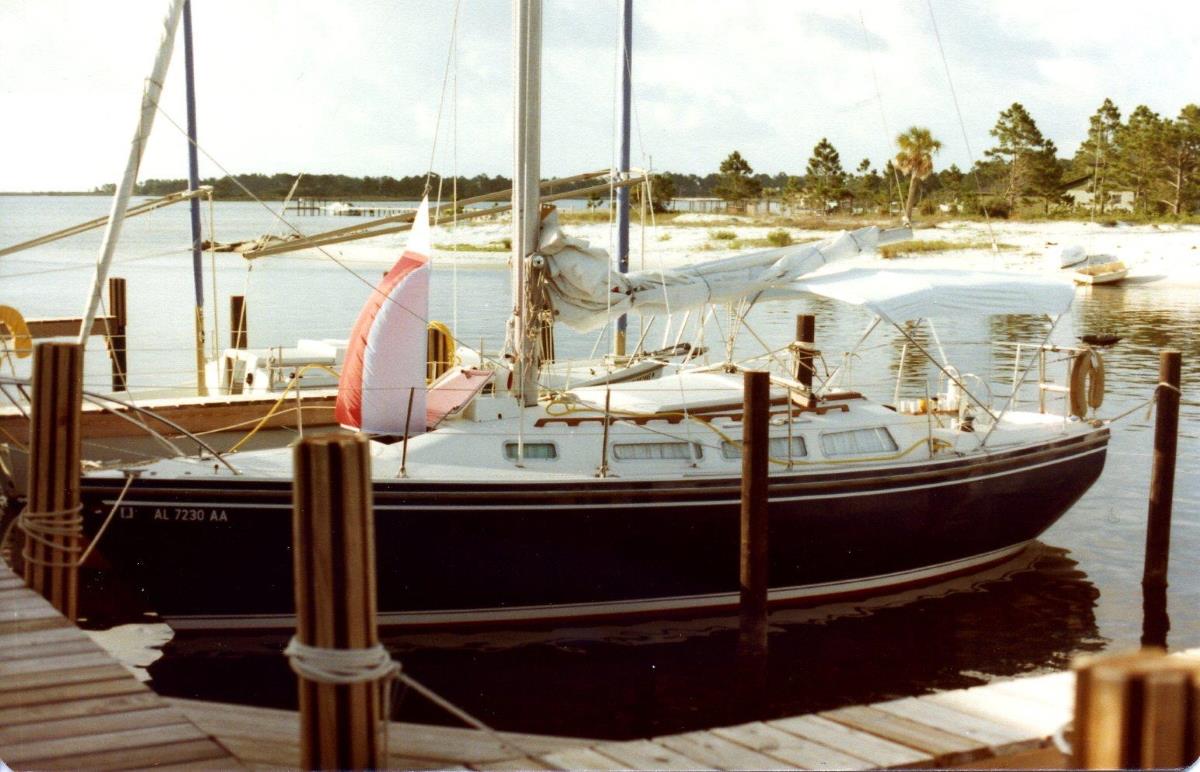
| Our
plans were to sail with our friends Cecil and Susan across the Gulf to
Sarasota (and then Cecil and Susan were to fly back to Mobile) – and
we would continue south, cross Florida at the Okeechobee Canal, and
then join up with Tony and Tish at Ft. Lauderdale and then head on
together to the Bahamas. |
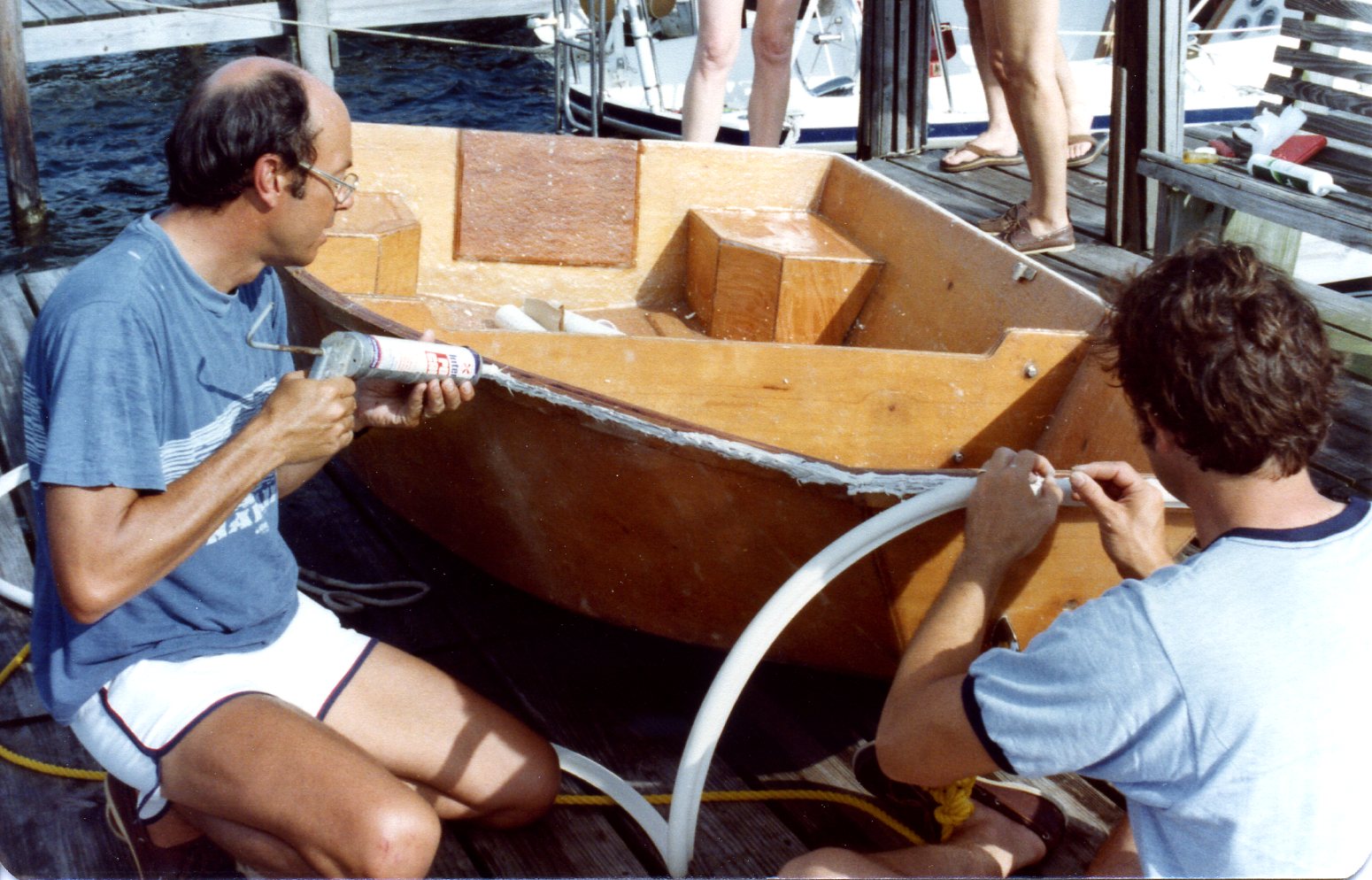
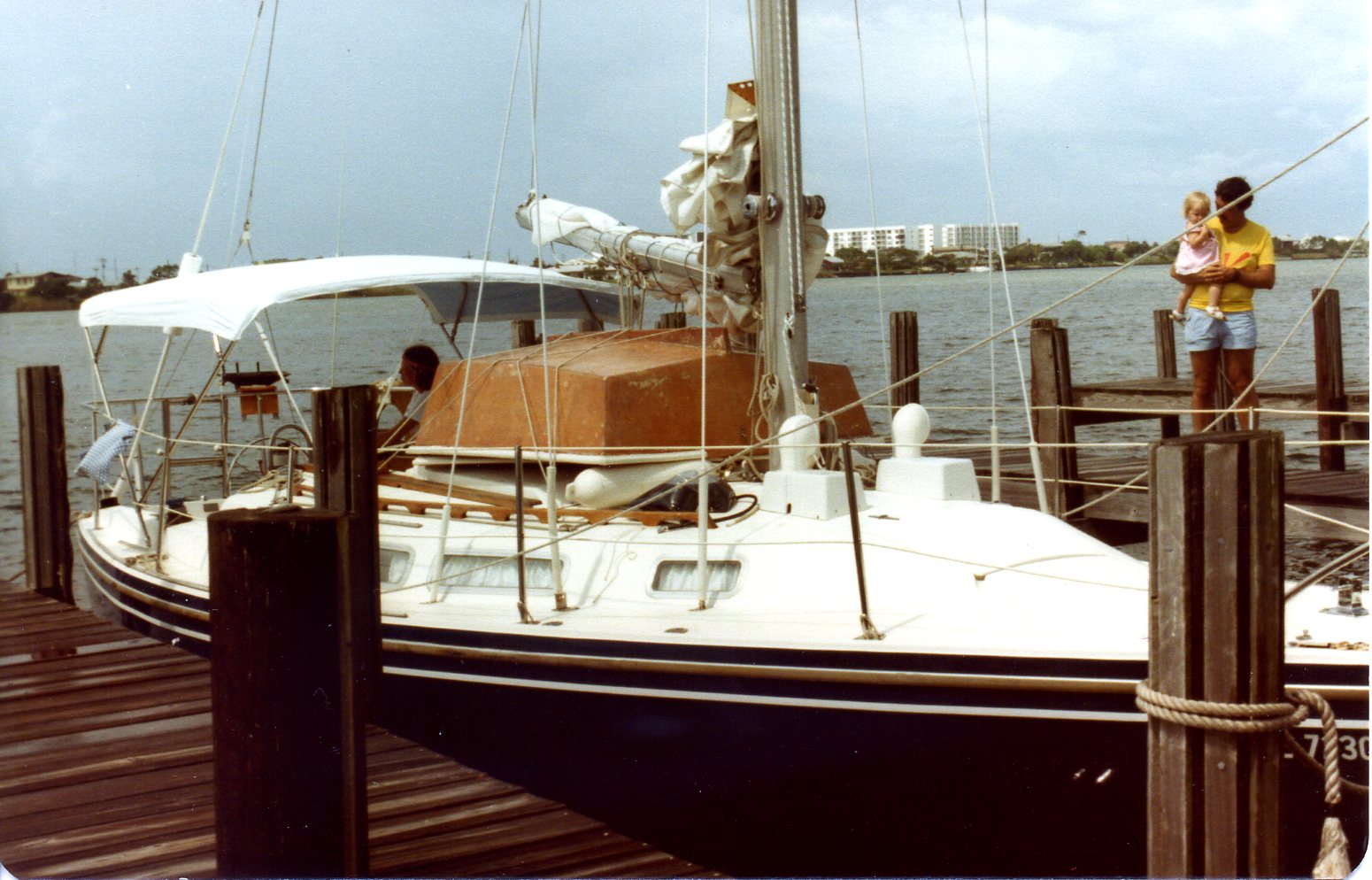
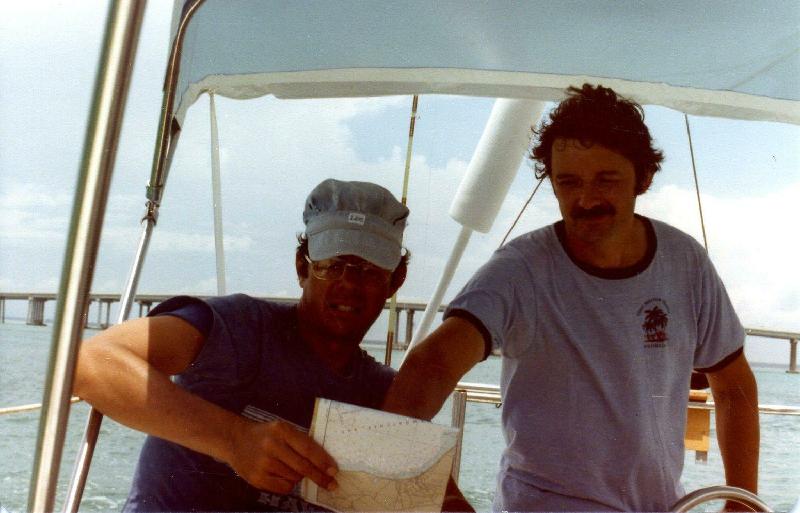
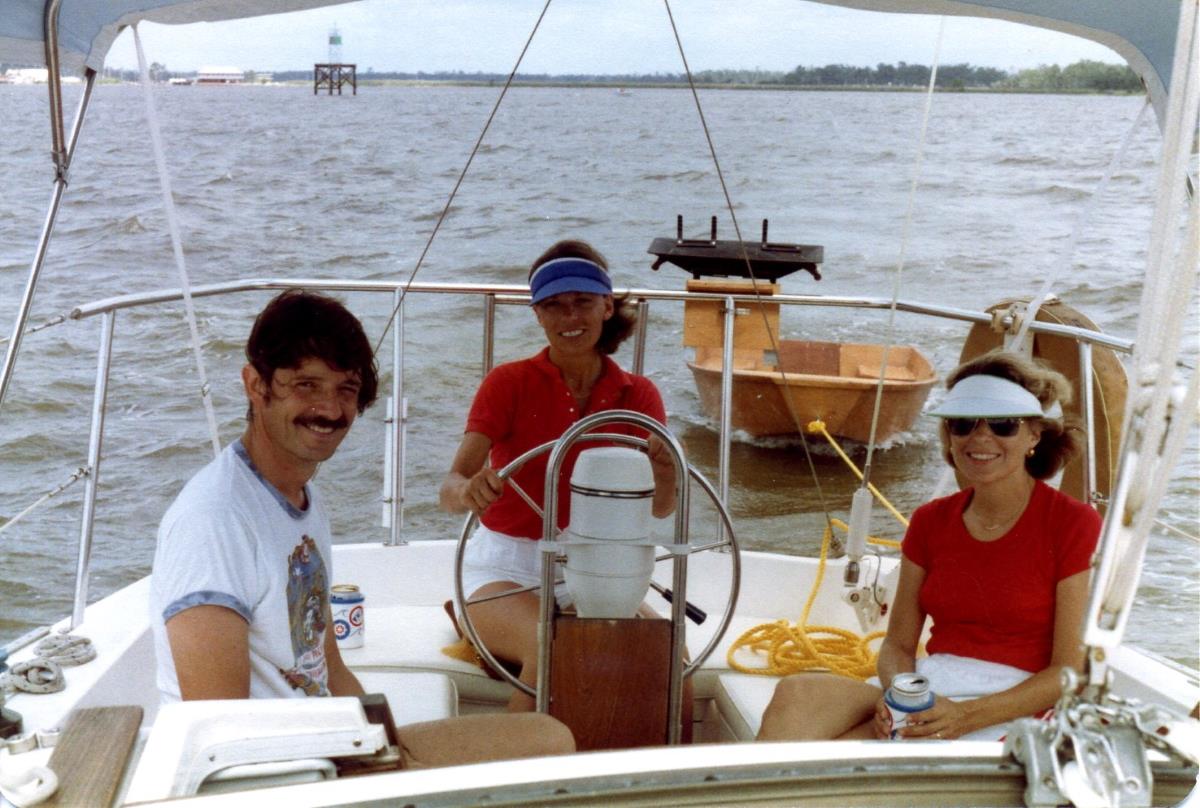
| Mid-way across the Gulf our
forestay broke lose at the masthead (caused
by constant pounding sailing directly against strong waves produced by
an earlier storm), and we had to turn directly east
to Tarpon Springs. At first that merely delayed us a bit. But we were able then to head South – only to run aground in a poorly marked section of the intercoastal waterway, requiring an expensive rescue and repair of the Marionette, using up all the money saved for the trip. Once the Marionette was repaired, we had to turn back to Mobile – our summer plans (like everything else) completely ruined. Then just to add to the misery, we would lose our lifeboat we were towing as we sailed against strong headwinds and choppy waters on our return back to Mobile! |
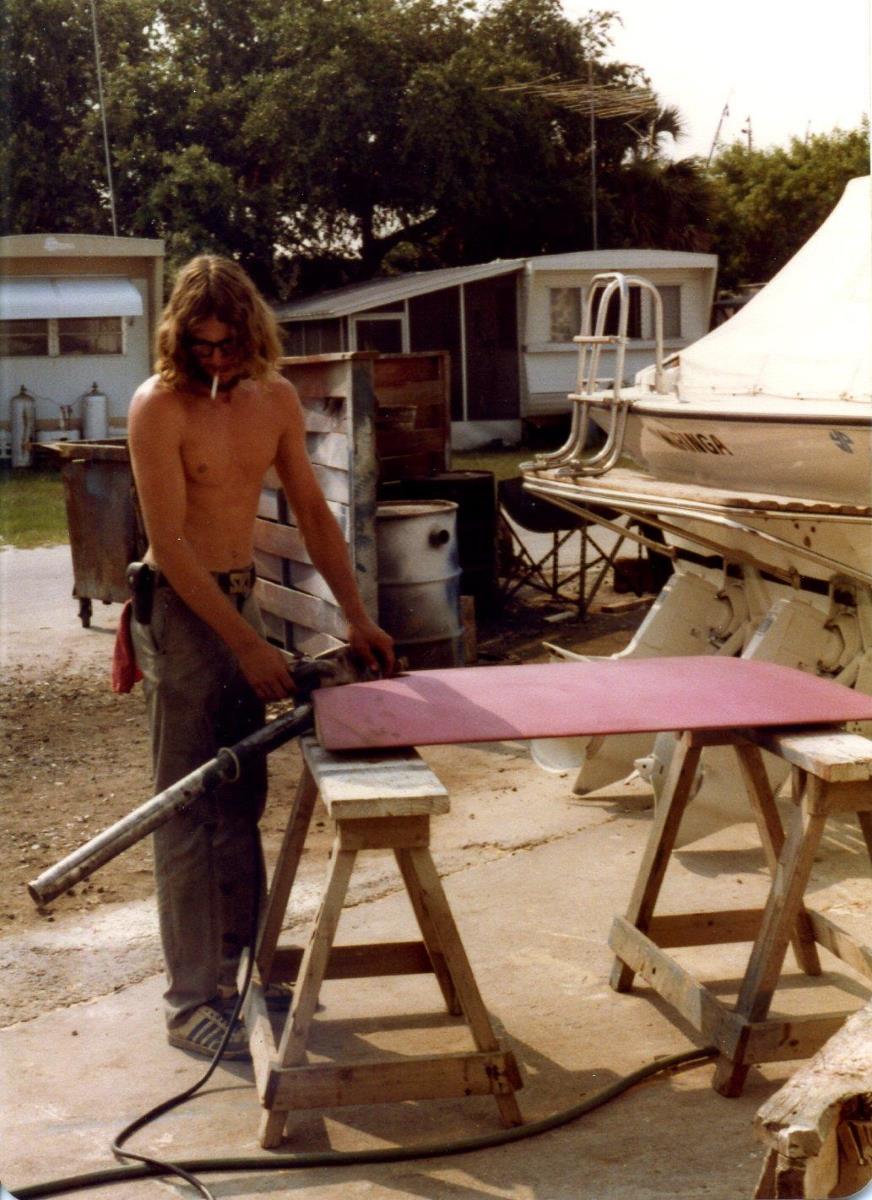
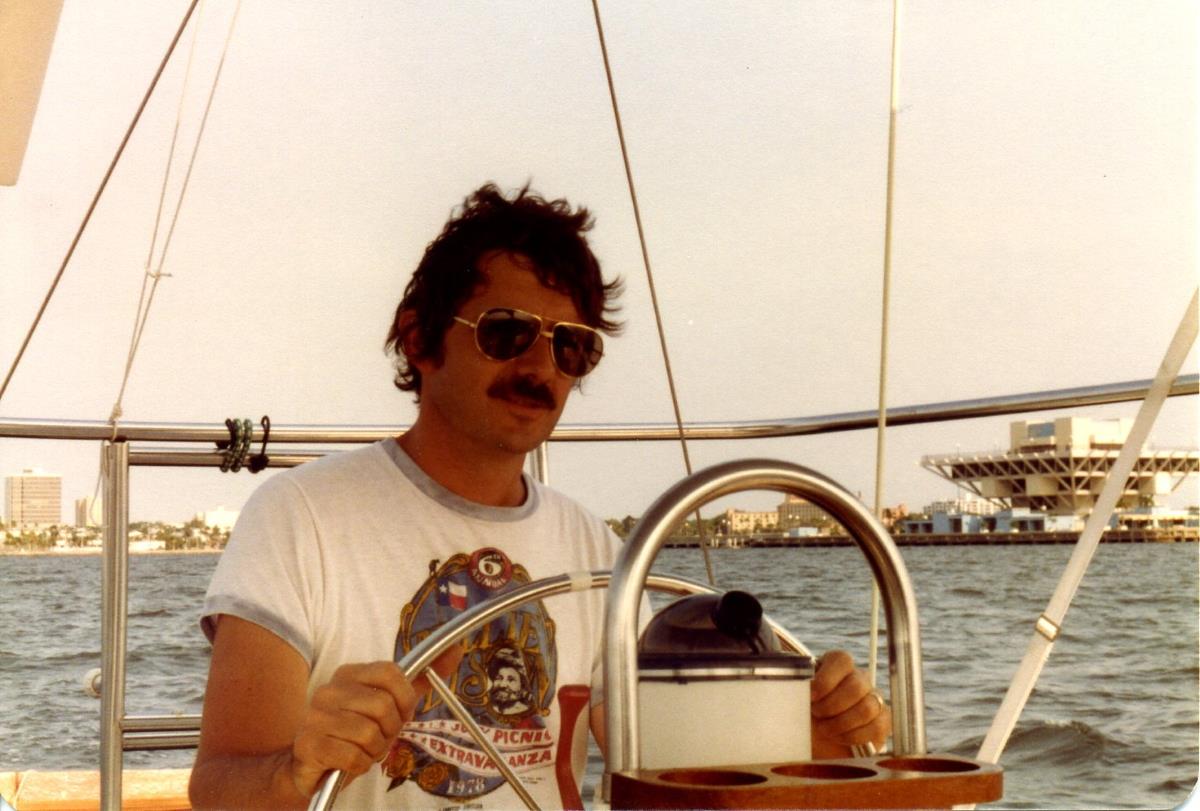
| On a quite different front … I was very disappointed when a star student of mine that I had worked hard to get scholarship support for her to study economics in Switzerland wrote me from Switzerland to tell me that she was leaving all that behind. She had moved in with some community called L’Abri operating in Switzerland … a community that seemed to engage young people of college age in deeper discussion and reflection on the Christian life. ... What? Was she becoming some kind of spiritual hippie? |
| Ironically, some
mere ten years later L’Abri, headed up by Francis Schaefer and his wife Edith, would
become for me a major inspiration as I tried to understand
exactly what I – at
that point also a Christian – was called to be
and do! But at the moment I
was
not ready for this … at
all!
|

|
|
Withdrawal
I had no idea how ripe I was for a major catastrophe. But in the spring of 1982 my life began to shift, slowly but surely. It all started quite simply. I found myself less and less at home, hanging around more and more with my students or spending time with my buddies at the Mobile Steamship Association. I didn't head home immediately after meetings, but just hung out. When I did get home, I would head up to my office in our home to work on drawings of a sailboat that I was designing and planning to build, one intended to be able to sail us around the world. I was simply slowly withdrawing emotionally from the world of what seemed like massive – and crippling – responsibilities, ones that called on me to perform services and undertake responsibilities that were humanly impossible to meet. I continued to meet my responsibilities at the university. Those were fairly well defined – though they felt increasingly lifeless or stagnant, not having opened any new vistas for me in several years. However on the home front I was feeling worse than stagnant. Here was where I felt myself under the obligation to "man up," to find solutions to the burdens laid on us, but obligations that I simply could find no way to carry through on. Thus I began to feel my particular responsibilities as life-crushing. Actually, Martha never complained or even commented much about what was happening to me – not wanting to add to the emotional burden I had now been carrying for quite a while. Actually, I really had tried not to bring her into our financial problems, and instead tried to handle things myself – though certainly she was always well aware of our deteriorating situation. This was both our understanding of what it meant for me to be that "man." As the spring of 1982 turned into the summer, I could feel myself disengaging emotionally from the home front ... from everywhere actually. Pulling away (August-December 1982)
In early August I told Martha that I wanted to be off by myself. I had a life to sort out – on my own. I proposed to move into an apartment of my own. But Martha said that she would rather be the one to move out – to live with friends – for she did not want to live alone in a house that was so vulnerable to intruders. So we separated. I stayed in the house, and she moved down by the bay with our friends Susan and Cecil. Then in early December of 1982 by some kind of miracle (!!) someone came around to see if we would like to sell them our house. We jumped at the chance. We sold the house, and were able to liquidate all our other obligations with the proceeds! Now houseless, I moved into a townhouse apartment. Meanwhile Martha continued to stay with Susan and Cecil, while I tried to sort out the still quite uncertain feelings I had about my life. At Christmas, now out from under our debt burden for the first time in three years, we decided to take a trip together to Mexico City for a week. It was good to be traveling again. But somehow this was not enough to bring me back into our old relationship. I still felt emotionally very removed from Martha. Actually, I still felt emotionally removed from most everything. In fact, the sense of freedom afforded by both the loss of the cherished house and the lifting of my other financial obligations served only to make me all the more determined to be totally "free." I decided to unburden myself of all remaining involvements I had beyond my immediate "self." Cutting ties
Thus one morning in early January of 1983 (January the 3rd, to be precise) I woke up determined to ask Martha for a divorce. I then proceeded that same day to the Dean's office to announce that I would be quitting teaching at the end of this school year in June. Wisely, the Dean, who was somewhat aware of the strain I had been under, advised that instead of quitting I simply take a year's leave-of-absence from my teaching responsibilities. I agreed to do this instead. Actually at that point, I did not really expect to ever return to the university. A leave-of-absence was just a way of "playing it safe." Of course I had no such "year's leave-of-absence" option with Martha. Anyway, given the mood I was in, I wasn't terribly focused on the thought of ever returning to anything again. That was the last thing that was on my mind. From the moment of this declaration things proceeded swiftly. Within three weeks of my decision to cut free of all attachments, Martha and I were divorced (thanks to the work of our lawyer friend Cecil, it all happened very quickly and amazingly amicably!) A few days later she returned "home" to Texas. And that first weekend back in Galveston she met the Coast Guard commander, Mike, who himself had recently arrived in Texas from his posting in Mobile. In Mobile he had become friends with Susan and Cecil, and it was Susan who was inspired to call Mike, asking him to introduce Martha around to his new friends. She wanted to help get Martha settled in to her new world (actually not so new to Martha!) in Texas. And wouldn't you know, the two of them, Martha and Mike themselves, immediately hit it off. In any case, by the end of January 1983, I knew that I was now set entirely on a new course in life, with nothing of the old to hold me back. |
